Blog
Are you curious about tips & tricks or more important information about your dog or cat? Then you have come to the right place. Discover here everything from A to Z that you need to know for your pet. Subscribe to our newsletter and stay informed about our latest monthly blogs.
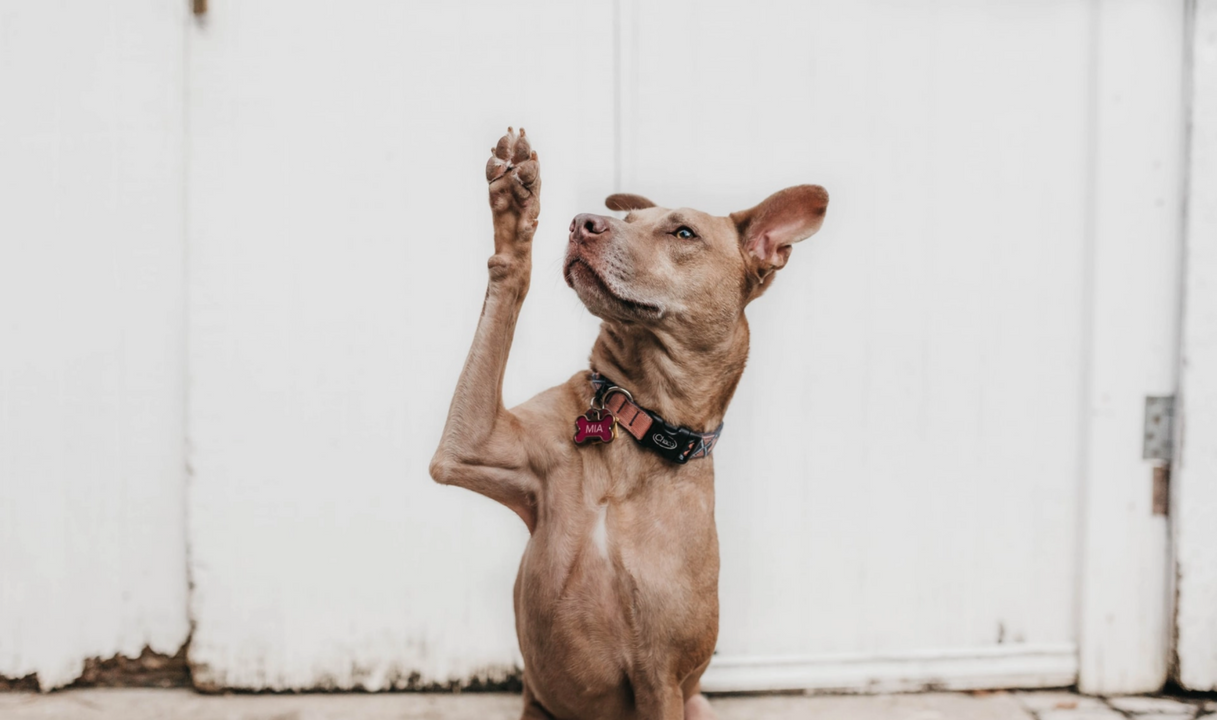
Blog
Are you curious about tips & tricks or more important information about your dog or cat? Then you have come to the right place. Discover here everything from A to Z that you need to know for your pet. Subscribe to our newsletter and stay informed about our latest monthly blogs.

ALL ARTICLES
DOGS
CATS
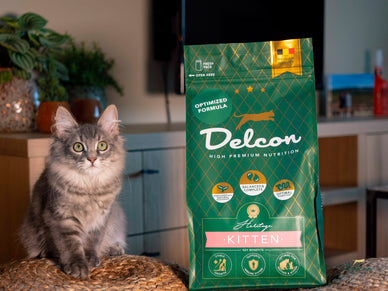
The kitten checklist: the preparation
The kitten checklist: the preparation
The day is almost here: your new kitten can go home! Here's to years of fun and love with your new four-legged friend. But until that day arrives, there is a lot to prepare. To make it a little easier for you, we provide you with a checklist! This way you will be perfectly installed before your new best friend comes home.
Preparation
1. Registration
In Belgium, you are obliged to chip your kitten. Do not forget to register your animal's chip afterwards. Your name and address will be linked electronically to this chip. Are you adopting a cat that already has a chip? Then be sure to update the old data to yours. If you ever need it, your cat can be identified that way.
2. Deworm
After (and even during) birth, kittens can become infected with worms. They are very susceptible because their immune system is still developing. The solution for this is to have your animal dewormed by your vet. Please note that this is not a preventive solution. The remedy only kills the worms that are already present. So be sure to have your other pets checked and/or treated as well.
3. Deflead
Worms are not their only enemies. From birth, they are also susceptible to fleas. Protect them as early as possible! You can do this by applying monthly product using a spray or pipette.
4. Vaccinate
Just as we need vaccinations, you should also vaccinate your animals. This way they are protected against various infections and diseases. Check with your vet when your kitten should receive which vaccination and make your appointments immediately!
5. Castrate or sterilize
Since 2016, it has been mandatory for every cat that is sold or given away to be spayed or neutered. Spaying brings many benefits such as preventing uterine infections or tumors, no unwanted litters, less risk of diabetes,... Spaying in turn reduces spraying behavior and fighting.
If you have a cat that has not yet been spayed or neutered, we strongly recommend that you do so at around 4 to 6 months of age.
6. Nutrition
The first few days with your kitten it is best to feed it the same food the breeder gave you. It is a stressful period for them with a lot of new situations. After a few days you can gradually switch to other food by mixing a bit more of the new food with their old food.
There are many different types of cat food. So make sure you choose food that supports your cat in all areas where needed! Would you like advice on the right food for your kitten or cat? Then feel free to ask us your question!
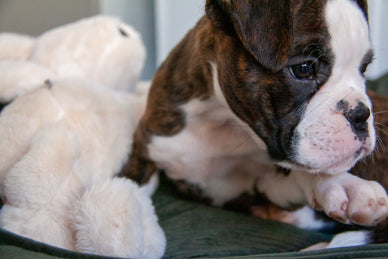
Potty training your puppy
Puppies already learn a lot of "manners" from their mothers but once the puppy arrives at your home, it is your responsibility to raise this puppy correctly. One of the first training sessions during this education will be the toilet training.
From the word alone, many go berserk. Potty training, so crucial but where and how to start? Well, let us help you. Complete potty training usually takes 6 to 10 weeks. With the following tips you will get your puppy fully housebroken in no time. Peeing in the house will be completely a thing of the past.
Be vigilant
One of the most important aspects of potty training is watchfulness over your puppy. Always keep an eye on him. As soon as you notice a change in his behavior, let him out.
Hou een vaste routine aan
Honden zijn gewoontedieren en hechten veel belang aan routine, begin dus met het opstellen van een dagschema. Neem de pup dagelijks op dezelfde momenten mee naar buiten om hun behoefte te doen, zoals bv. nadat ze gegeten hebben, nadat ze wakker worden, voordat ze in de bench moeten en opgelet als ze rondsnuffelen opzoek naar een plek, dan is het zeker het moment om de pup buiten te plaatsen. Na verloop van tijd zal je de signalen die je pup je geeft beginnen opmerken.---article-upsell-here---
Choose a fixed place in the garden
Provide your pup with a fixed place to do his business in the garden. Praise your pup to the skies, so to speak, after he has done his business in his regular spot. A treat will also encourage the pup to do his business in the right place next time.
Every time your pup gets ready to do his business in the right place, link this to the same word or command, such as "do a pee". If you also include this in the routine, your dog will understand faster what you want from him.
Punishment is counterproductive
It seems logical, the pup has made a mistake and is consequently punished. Yet this is not the best way to work. The panic you cause makes it harder for the pup to understand what is going on. Because of this it can happen that he does not want to do his business in your presence because he links this to an angry reaction. He will do his need secretly and this is the last thing you want.
Do you catch your pup peeing in the house? Ignore him for a while. This ensures that this behavior is certainly not rewarded, but you also do not scare the pup.
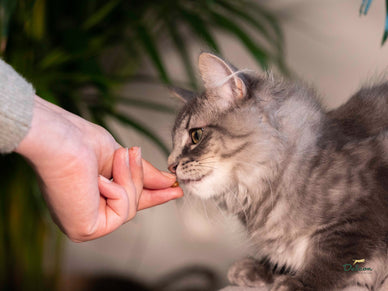
De kitten checklist: de thuiskomst
The day has FINALLY arrived! Your kitten can go home. All preparations have been made and you can start your adventure together. But beware, a move like this can be very stressful for your kitten. Here are some tips to make your kitten more at ease.
Tip 1: Give your kitten time and space
First and foremost, give your kitten time and space to get used to the new situation. Let them gradually discover each room. Only when they are completely relaxed in one room, let them discover the next room.
The first place you should let your kitten discover is their hiding place. A place where they can unwind. Cats often prefer dry, warm and comfortable hiding places such as a cardboard box with a blanket.
Extra tip: for the first few nights, place a warmth jar in their nest. This will mimic the warmth of the kitten's mother. This way the transition to 'being alone' is also a little less drastic
Tip 2: Socialization
The socialization of your kitten starts from birth. It is very important that the breeder has paid enough attention to this socialization and that the mother cat has set a good example. The socialization will automatically continue in your home. Be consistent in the upbringing. Encourage good behavior by rewarding them and bad behavior is best learned by raising your voice or clapping your hands. Physical punishment is never the solution here, as it often makes the problem behavior worse.
Tip #3: What to do with that litter box?
The mother cat normally teaches their kitten how to use the litter box. Often you are already helped by pointing out the litter box to your kitten and putting him in it after certain moments such as after waking up, after a meal or when you see that the need is the highest.
Keep this litter box clean and empty it regularly, this is very important for your cat's health. Just make sure you use the right cleaning agent because some are toxic to cats.
Tip 4: The dreaded houseplant
Your houseplants may not be as harmless as they seem. Some houseplants can be extremely toxic to your kitten. Most cats ignore plants but your kitten still has to explore the world, even that one houseplant is oh so interesting to them. So it's best to keep it away from your kitten!
Tip 5: Letting your kitten explore the outside world
We advise you not to let your kitten outside until it is:
is older than 6 months
Has had all its vaccinations
Is fully accustomed to its new surroundings
When the day comes to let your kitten outside, pick a day with nice weather and stay in the neighborhood first until the kitten can find her way back home.
Extra tip: Install a cat flap. That way, your cat can choose when to take her outings.
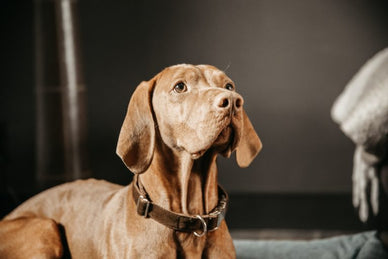
Breed in the spotlight: The Vizsla
The Hungarian Standing Dog, better known as the Vizsla. These Hungarian hunting dogs were initially used as 'pointers'. 'Pointers, what's that all about?" I can hear you thinking. Well, these are dogs that walk the land in search of game such as pheasants or partridges. When they have found a bird, the dog tightens up so that the bird doesn't dare move. This gives the hunter a good chance to shoot the bird. Meanwhile, it is more common for the Vizsla to be used as a pet for your family rather than in hunting.
There are two types of Vizslas, the short-haired and the wire-haired Vizsla. It is generally said that the wirehaired Vizsla is a little quieter than the shorthaired Vizsla.
CHARACTERISTICS:
Origin: Hungary
Life expectancy: 12 to 15 years
Character: energetic, affectionate, friendly and sporty
Weight: Bitch: 18-25 kg, male: 20-29 kg,
Height: bitch: 54-60 cm, male: 58-64 cm
Colors: wheat yellow to light brown
Did you already know these 5 fun facts about Vizslas?
The velcro dog
The Vizsla sticks so hard to its owners that you can almost compare them to velcro. The fact that these dogs are so affectionate is because they were once bred to work with the hunter. So they are only too happy to rely on human attention. Train your Vizsla early enough to be alone. This way you can avoid the development of separation anxiety.
Smart dog but oh so curious
Smart, they are. Learning commands and tricks is done in 1, 2, 3 but still they are very easily distracted. Always looking for a new adventure.
Snow? Get that winter coat out of the closet quickly
Unlike many other breeds such as Labradors and Golden Retrievers, Vizsla's have no undercoat. So they catch the cold faster than their companions. So, duffel them well during the winter.
Zzzzoef! There goes your Vizsla
Vizslas are extremely fast. They are among the top 10 fastest dog breeds in the world with a top speed of 40 km/h.
Almost no Vizsla' left because of the World Wars
During WW1 and WW2 the Vizsla breed was virtually exterminated. Fortunately, there were still some Vizsla's smuggled into Hungary so the breed still had a chance to not disappear from the face of the earth. Fortunately!
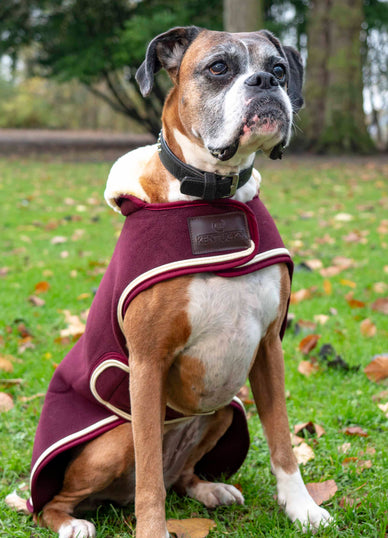
Breed in the spotlight: The Boxer
The boxer is a rather young breed that originated in the late 19th century in Germany. Originally intended as a fighting and butchering dog, it later emerged as a beloved family pet.
CHARACTERISTICS:
Origin: Germany
Life expectancy: 10 to 12 years
Character: Brave, Intelligent, Loyal, Active
Weight: Bitch: 25-29 kg, dog: 27-32 kg
Height: Female: 53-60 cm, male: 57-63 cm
Colors: White, Brindle, Light Brown
The Boxer at a Glance
This athletically built dog will make every effort to become part of the family. He is active and very energetic, all days he is ready for a new adventure. It is a must to always provide your boxer with enough mental and physical challenges. And take extra precautions because during his adolescence he seems to be a mess. But with the right approach and consistent training you can train this dog to be the perfect house dog.
Curious about 5 fun facts about the boxer?
The comical Boxer
The Boxer is a real comedian. His puppy behavior stays in his system for a long time. That you bruise with this breed is no secret to boxer owners. They all mean well but the dog is extremely playful and occasionally a bit clumsy. Give your dog enough space and exercise (with consistent training) to get rid of his energy!
No free game for burglars
Boxers are not aggressive dogs, but they are real watchdogs. They are usually no barkers but their powerful appearance often says enough when a burglar bumps into your Boxer. His pack is number 1 and the Boxer will protect it with his life.
Playful with a gray muzzle
When you say Boxer, you immediately think of the character trait playful. The playful nature does not stop after their puppyhood either. They remain a playful dog into their old age.
Small demolishors
Have you already come home and seen some destroyed things? It happens more often than not that Boxers break things because they get bored. So it is your job to make sure that your Boxer always has enough entertainment when he is left alone. Build up the "alone time" at a steady pace.
Once a Boxer, always a Boxer
Boxers are contagious and affectionate dogs. If you are an owner of a Boxer yourself or if you talk to an owner of a Boxer, they will probably tell you that they never want another breed. Once a Boxer owner, always a Boxer owner.
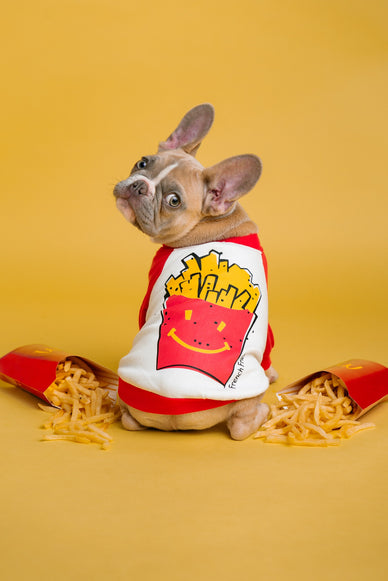
Help, my dog is begging at the table!
Do you have a begging or scrounging four-legged friend running around the house? If so, it can be quite annoying. Dogs are of course by their instinct quite fixated on food. But the typical begging behavior they exhibit is mainly learned by the owners themselves.
And this we understand from time to time. If your dog with his huge puppy eyes stares at you, you can sometimes hard to stop you from him something good to slide. Unfortunately, this encourages the annoying begging behavior. This can be disastrous for both the owner and the dog for several reasons.
Dogs are smart animals and when dogs beg, it is because we have taught them to and your dog knows how to manipulate you to get what they want. Do you find it also pitiful that you can eat as good as every day something new whereas your dog gets every day the same food or do you also want show your love to your dog by letting him feast along of your meal? It does happen often and in several families but still, this is absolutely not the best way to act. Let us explain why!
Atmosphere and friendliness: 0/10
Dogs do not make the same association with food as humans do. For us, food is a social event, it is something cozy to share with your family or friends. It is a moment of relaxation and enjoyment. Unlike dogs, for them food is a means of survival. As soon as they smell food, they start making an effort to get it. In a life-threatening situation it may be that begging is pure necessity but in modern home situations this is absolutely unnecessary, our dogs get enough food and therefore do not need to beg.
Dogs do not link begging (or eating from the table) to love from their owners. You rather show them love by giving them clarity, the correct food, play with them, ... But rewarding by giving food from the table does not belong here.
So it's time to unlearn it! You can do this with the following tips:
#1: Consistency is a priority
Even though it is not easy, when unlearning begging you must be very consistent. No more giving your dog food if he begs, not even a very small piece or on a special occasion. If you want to reward him with something sweet, grab a treat or a chew and give it to your dog at a time of your choosing.
#2: Keep your table manners and your dog separate.
Try to keep the "eating moment" and your dog separate. It often happens that the dog lies under the table while the family is eating but this is better not done. A dog that begs can cause restlessness at the table as they often try to get a piece of the food. It must therefore be made clear to the dog that he is not part of the eating moment. Send your dog, possibly with something tasty such as a chew, to his basket. This will make it clear to him that when the owners eat, he must leave them alone.
Tip: Do you have a new puppy? Then be sure to teach them this from the beginning. Eating time for the owners? Dog in his basket!
#3: Ignore bad behavior
Has your dog been used to begging for some time? Then it will make it a lot harder for you to unlearn this. It is possible that they ask for attention, squeak, bark to get your attention to get that one chunk out of your plate. Do not punish him for this, do not get angry or raise your voice but ignore him for a while. Because by giving him attention in any way while begging, you are rewarding him. So ignore him every time he shows begging behavior or send him to his basket and then say "good" or "good man". In the beginning you will have to repeat this countless times, but patience is a beautiful virtue. Over time, your dog will understand that begging is of no avail and will stop doing so.
It seems that begging is very difficult to get rid of but in practice this is not so bad. The main thing is to remain consistent, with patience you will come very far. You will do yourself and your dog a great pleasure with it. Your dog healthy and happy and you can enjoy your meal in peace again. Hang in there and good luck!
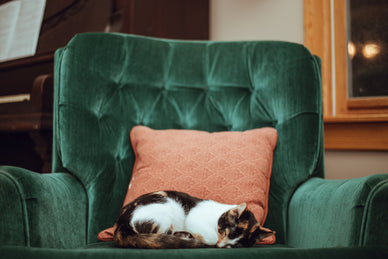
How can I help my senior cat?
It is sometimes hard to accept but our pets are getting older and may start struggling with age-related ailments such as decreased hearing or vision. Everyday activities increasingly become a real challenge. Fortunately, there are some methods that can help your aging cat.
Not too much change
Try to keep changes to a minimum but sometimes such adjustments are unavoidable. E.g. moving house or changes in the family are things that disrupt your cat's routine and thus cause anxiety. Make sure that any adjustment is done slowly. That way your cat can get used to it at his pace.
Fixed routine
Routine, routine, routine. Your senior cat will benefit from this. Your cat has a daily routine, and it becomes increasingly important as your cat ages. This is because your cat can get confused more easily. By following a structured routine, they can easily predict the day ahead, which makes them feel relaxed and happy.
Provide adapted food
Delcon also has cat food that was developed specifically for senior cats. Delcon Senior ensures that senior cats get all the nutrients they need so they can live out their old age in comfort. The nutrients glucosamine and chondroitin provide optimal cartilage support, while the prebiotics lead to optimal digestion. The exquisite kibble for your senior quadruped!
Mobility decreases
Just like people, cats become less mobile as they age. But it is not because they are less mobile that their daily needs decrease. They still need to eat, drink and go to the toilet every day, but finding their way to these things can be a little more difficult for them. Make sure your cat has easy access to everything at all times such as food, water, sleeping place, litter box, etc. So putting the litter box on floor 2 is no longer an option for your cat.
Health Check
Your aging cat may therefore have to deal with some aging ailments. Consult your veterinarian if you discover any symptoms in your cat. Scheduling a regular health check is certainly not a bad idea!
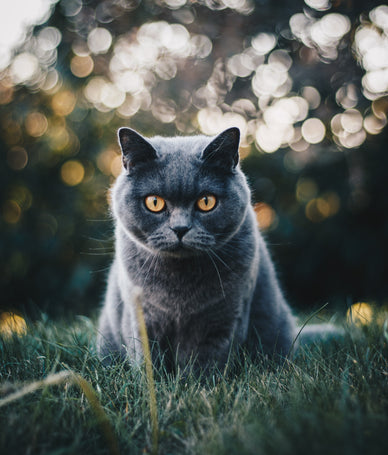
BLOG - Breed cat in the spotlight: British short hair - Delcon
In recent years, this breed came into the spotlight tremendously due to brilliant TV ads for cat food. It is a breed loved by many families because of their uncomplicated nature. They are friendly and quiet which makes them fit into just about any family - even when there are children or other pets in the family.
Due to their quiet nature, they are also not constantly seeking attention but rather going their own way. They also like living indoors more than roaming the streets. But beware, in situations they do not appreciate, they also show this firmly. So they sometimes dare to throw their full weight into the battle if you try to give them medication for example.
And beware: many call the breed the British Shorthair but you can leave out that "e". The breed is called British Shorthair.
CHARACTERISTICS:
- Weight range: 4 to 8 kg
- Eye color: blue, copper, gold, two different eye colors
- Expected life span: 12 - 20 years.
- Shedding tendency: average
Did you already know these 5 fun facts about the British Shorthair?
One of the most expensive cats in the world
The British Shorthair belongs to the group of the most expensive cat breeds in the world. The usual price for a kitten is generally around 350 euros, but it can go up to 1000(!) Euros. The increase in price has mainly to do with the pedigree of the kitten.
Oldest cat breed
The British Shorthair has been around for a while, it is the oldest cat breed in Great Britain. It is told that the British Shorthair was taken by the Romans to England where they lived in isolation for a long time. Only after the World Wars was the breed bred again.
Preferably with two
Although the British Shorthair can easily live alone, we recommend to provide him with a playmate. The cats usually just go to sleep when everyone is away from home, and wake up when they get home, which can make for a rather boring life. They will always welcome a playmate with open arms.
The British Longhair came into being by accident
Besides the British Shorthair, there are also British Longhairs but they were not bred with intention. By crossing with the Persian cats, the British Longhair (also known as the Lowlander), the half-long variant of the British Shorthair, also came into being completely by chance.
Spectacular coat
The breed has therefore grown considerably in numbers and the number of color variations in which the British short hair occurs has also increased. Their color can be divided into as many as 5 groups:
1. The classic colors such as black, white, blue, chocolate, lilac, red, cream and tortie
2. The Silvers like Smoke, shaded silver, chinchilla and golden
3. The Tabbies such as spotted, macherel, blotched and ticked
4. Colourpoints
5. Particolours
Did you know that single-color kittens sometimes have a fuzzy tabby pattern in their coat? This is called ghost markings or ghost drawings. These fade back as they get older.
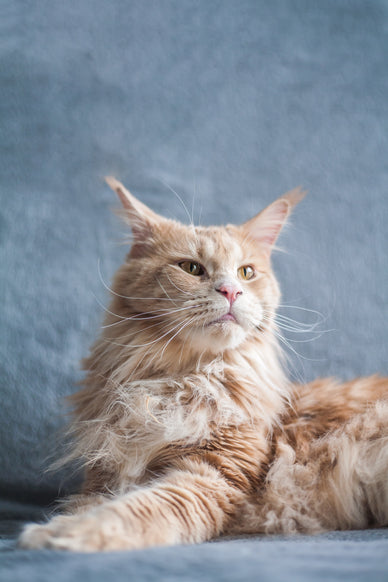
Breed cat in the spotlight: The Maine Coon
The Maine Coone looks very imposing and is therefore a very popular breed. This tough looking semi-longhaired cat comes in a variety of colors. They are known to be friendly, playful and very attached to their owners. They also enjoy the outdoors all too much, regardless of the weather conditions.
Curious about 5 facts about this breed?
CHARACTERISTICS:
- Origin: United States
- Life expectancy: 12 to 15 years
- Character: Loving, intelligent, affectionate, tolerant, calm
- Weight: Female: 3-6 kg, male: 6-8 kg
The legend of the Maine Coon
It is said that this breed was originally found in the North American state of Maine. Hence the first part of their name but did you know that the second part refers to raccoon (the English word for raccoon)? Legend has it that the Maine Coon was created by a cross between a raccoon and a lynx and the thick, long tail of the Maine Coon also reminds everyone of the tail of a raccoon. A lot of elements that might make you doubt but let's be clear: the legend is completely made up.
A more realistic story is that the Maine Coon probably originated because sailors brought long-haired cats with them on their trips to Maine and in this way these cats reproduced with the cats that already lived there.
Impressive cats
The Maine Coon is also part of the select group of largest cat breeds that people have as pets. The average weight of a Maine Coon male can go up to 9kg. Of a female cat, this goes up to 6kg.
Did you know that this breed also have a record to their name? The longest cat in the world is a Maine Coon, his name is Omar and he counts as 1.20 meters long.
Great love of water
This intelligent breed has a great interest in their surroundings and deal with new things very curiously. Most Maine Coons also love running water. With a drinking fountain, you will make them very happy. Their coat is water resistant and they are very good swimmers.
Voice
Surprisingly, the Maine Coon has a very soft voice while you would expect a very different sound from such an imposing cat. They squeak and twitch rather than meow. It resembles a mix of meowing and purring.
The dogs in the cat world
They are so social and love the people around them. They are known to be friendly, loyal and playful. In addition, they are great with children and other animals in the household. You can teach them tricks yourself, just like dogs!
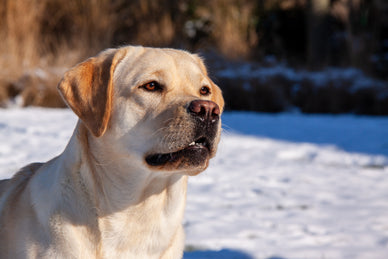
Breed in the spotlight: The Labrador Retriever
The Labrador Retriever is one of the most popular breeds in Belgium and perhaps even the world, and for good reason. It is a breed that loves everything and everyone. They are extremely friendly towards people and other animals and therefore fit perfectly within a family as a pet. Curious about some interesting facts about the Labrador Retriever?
CHARACTERISTICS:
- Origin: Newfoundland
- Life expectancy: 10 to 12 years
- Character: Balanced, intelligent, gentle, social, loyal
- Weight: Bitch: 25-32 kg, male: 29-36 kg
- Height: bitch: 55-60 cm, male: 57-62 cm
- Colors: Black, chocolate brown and blond
The colorful Labrador
The official colors are blond, brown and black. In the past, mainly black Labradors were bred. Only in the 1970s did blond begin to increase in popularity. The brown color was first seen as a flaw in the breed, only later was it also considered one of the official colors of the breed. The brown Labrador has since become so popular that it is being bred at far too high a rate to meet demand. The result is that dogs with this color sometimes have more defects. The brown Labrador, for example, does not live as long as the blond or black Labrador.
The special ones
In addition to the official colors, you also have some 'speciallekes' that are not officially registered. For example, you also have the silver, red, charcoal and champagne Labrador of which the silver Labrador is the most controversial. This color is caused by a dilute gene from the brown Labrador. Such a dilute gene causes the animals to have a lighter coat. Thanks to this gene, Labradors get this special color.
Retriever
The name says it all. Labradors love enormously to carry things and bring them to you. Fortunately, they are very gentle, you can even put an egg in their mouth without breaking it. But be sure to put your slippers away, because in no time your Labrador will have run off with them!
Hunting dog
Initially, the Labrador was bred to hunt game in the water. Their job was to retrieve the shot game from the water. Fortunately, they love water!
Otter Street
Did you know that the tail of a Labrador is often described as the "otter tail". Why, do you think? Well, this is because the tail has many similarities to that of an otter: broad at the start that runs to a narrow tip. It is also short-haired and the Labrador uses it while swimming to steer better. Just like an otter
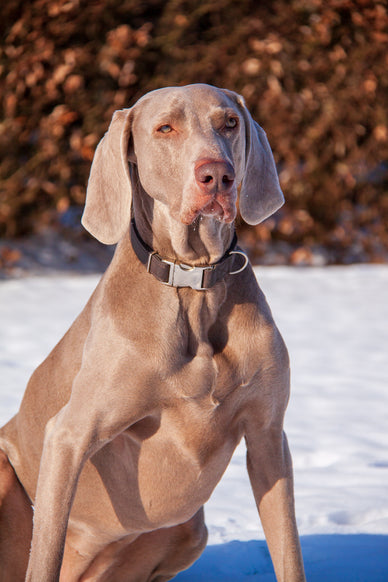
Breed in the spotlight: The Weimaraner
The Weimaraner or the Weimaranian Standing Dog originated in Germany and was originally bred as a hunting dog. This is because they also belong to the club of the fastest dog breeds in the world. The Weimaraner is a large, athletically built dog that is inexhaustible. Owners of this breed should learn how to calm this breed and control their behavior. Curious about some interesting facts about the Weimaraner?
CHARACTERISTICS:
Origin: Germany
Life expectancy: 11 to 14 years
Character: Stubborn, Reticent, Energetic, Intelligent
Weight: Bitch: 25-32 kg, dog: 32-36 kg
Height: bitch: 58-64 cm, male: 64-69 cm
Colors: Mouse gray, silver, silver gray
Real water rats
Almost all Weimaraners love water and are great swimmers. This is due to the flippers between their toes, which allow them to easily paddle through the water (just like Retriever breeds like the Labrador and the Golden Retriever), and it also makes them very suitable for hunting in water.
Nickname: the grey ghost
Most breeds have a nickname and this is true for this breed as well. They are also sometimes called the grey ghost or the gray ghost. The name is fairly obvious, because of their gray and smooth coat but it is also because they can run so fast that sometimes you can only see their gray shadow.
One of the fastest breeds in the world
They are among the fastest officially recognized dog breeds in the world, with only a few dog breeds physically capable of surpassing them. A Weimaraner can reach a top speed of as much as 55 mph while hunting, so don't challenge them to a running race.
This is an important fact for Weimaraner owners, as such an avid runner needs space to run around. Try to find a large dog park or field where your friend can run, or start practicing a sport together like jogging.
Real cuddly bears
It's incredible how attached Weimaraners are to their owners. They want to be with you constantly and will also follow you everywhere, even into the toilet. So don't be surprised if your Weim clings to your leg and won't let go. But they do this out of love for their owner. So you get an enormously loyal friend, who would do anything for you, and who will be there for you when you need him. Moreover, they are insanely cute, so who can say no to that?
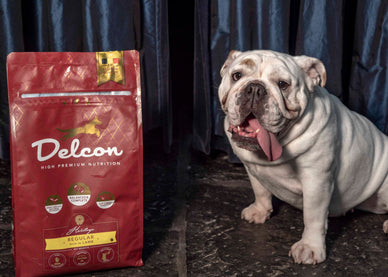
Breed in the spotlight: The English Bulldog
The English Bulldog: friendly, courageous and loves attention. This struishly built, short-legged and well-muscled powerhouse may have a wrinkled and "sourpuss" face, yet they symbolize courage and tenacity. This loyal four-legged companion adapts tremendously well within a family, is good with children and suitable for families with a smaller yard or even an apartment.
CHARACTERISTICS:
Origin: United Kingdom
Life expectancy: 8 to 10 years
Character: docile, friendly, stubborn and social
Weight: Bitch: 18-23 kg, dog: 23-27 kg
Height: bitch: 31-40 cm, male: 31-40 cm
Colors: White, Light Brown, Piebald, Fawn & White, Brindle & White, Red Brindle, Red, Red & White
The Bulldog in summary
The Bulldog can hardly be compared to any other breed. The look with their loose skin, wrinkles across their face, their compressed nose, small ears and drooping jaws makes them stand out very well. In addition to their expressive appearance, Bulldogs have some fun facts! Curious?
Stubborn
English Bulldogs are extremely friendly and gentle little dogs. They are cheerful, like to be with their family and they do not often say no to a hug. An occasional game can charm them but let them do something they do not want to do? That is another matter. Thanks to their stubborn and headstrong character, they do not easily do anything they do not feel like doing.
Fighting with bulls
The name says it all but Bulldogs used to fight with bulls. Biting bulls was a bloody sport that was common in the UK around 1200. The idea was that the Bulldog had to keep himself as low as possible so he could bite the bull in the nose. Fortunately, this bloody sport was completely banned in 1835.
Redundant Bulldog
After the ban on 'bull biting', the Bulldog became 'superfluous' so to speak as they were bred entirely for sport. Their days seemed numbered, luckily there were fanciers who still saw enough potential in the breed. They were bred again but this time to be more gentle. Since then, the dog was used as a loyal four-legged friend in the home.
Do not leave them alone with water
Their build, large head and short legs make it very difficult if not impossible for a Bulldog to manage in the water. Although some like to swim, it's still best to keep an eye on them!
Mascot
The Bulldog was often used as a mascot, just like the Soldiers of the United States. They were often called 'dog faces' or 'dog face soldiers'. But in the 3rd Infantry Division, they took the nicknames in a very different way. The Bulldog was officially approved as a mascot. In 1965, Walt Disney was even commissioned to draw out their mascot, thus Rocky the Marne Bulldog was born.
Health issues
Because the Bulldog is bred in a special way, there are often health problems. Therefore, there are now many variants of the English Bulldog, such as the Olde English Bulldog. This is a healthier and more active variant of the original Bulldog. It stands taller and straighter on its legs and has a less short nose which allows it to breathe easier.
Op zoek naar de ideale hondenvoeding voor je Bulldog? Die kan je hier terugvinden!
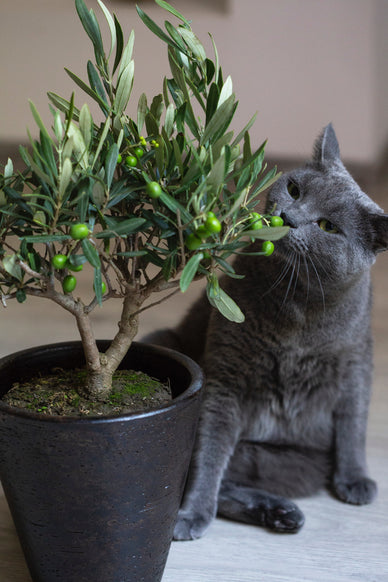
Be careful with houseplants!
Today is "Fascination of Plants day. Therefore I would like to emphasize the risk you take when you bring certain houseplants into your home.
A house full of plants gives you an 'indoor jungle' feeling and that can be very cozy. Add a faithful four-legged friend and the picture is complete. But it is not without danger. Do you have an overenthusiastic pet that likes to sniff around everywhere? Then your houseplant is probably not un-walked territory for them either.
There are several houseplants that are toxic to your dog or cat. Unfortunately, an animal intuitively does not know which plant is poisonous and which is not. After eating a piece of leaf, root, or seeds, your pet may experience neurotoxicity that can potentially leave behind damage. It is your job to keep your pet away from such a poisonous houseplant.
What are the consequences of such a poisonous plant?
If your pet has nibbled a poisonous plant, this does not mean that it will die (but there are cases where this can happen, so keep this in mind). If your pet has one of the following symptoms, do not hesitate to call your vet:
Burden of his intestines
Tendency to vomit
Excessive saliva production
Diminished consciousness
Behavioral changes
Drooling
Diarrhea
Swelling in mouth and throat
Skin irritation
Kidney failure
If you call the vet, also give the name of the plants you have in the house. That way, the veterinarian can respond appropriately.
Which houseplants are toxic?
Many of us have no idea which houseplants are poisonous and which are not. So be sure to check this out in advance!
We want to give you a hand. Here is a list of 10 popular houseplants that you should not bring into your home if you have a dog or cat:
Desert Rose or Adenium obesum
Chinese Evergreen or Aglaonema
Aloe vera
Wonder bush or Codiaeum variëgatum
Umbrella plant or Cyperus alternifolius
Dragon's Climb or Epipremnum Aureum
Lilies
Bird of Paradise Plant or Strelitzia Reginae
Household Palm or Zamioculcas Zamiifolia
Elephant ear or Alocasia
How do I keep my pet away from houseplants?
Maybe you're a lucky owner because their pet doesn't even drool at the sight of a houseplant. Rub your hands together because you have a lot less to worry about on this subject. Do you have a very curious jump-in-the-field in your house? Then it's a different story. You want your pet and your houseplant to stay 'round and healthy, so try to use these tips to keep your pet far away from your plant:
Very simple: put the houseplant out of reach of your pet. Think of it as a higher table, shelf on the wall, on top of a cabinet.
A separate plant room where your pets are not welcome
Scare your pet with odors they don't like. Mix lemon oil with water in a spray and spray it over their potting soil and leaves. Repeat this on a regular basis and after a given time your pet will lose interest in the plant
Make sure there is always a distraction in the room with the houseplant. This by e.g. a bone for your dog or cat grass for cat ready. In this way you get rid of boredom and they will be less interested in the plant.
Tip: in general, young kittens are more interested in plants than adult cats. This is because kittens are not allowed outside yet and therefore look for distraction elsewhere. For the first year, it is better to put your houseplant in a place where your kitten is not allowed to go.
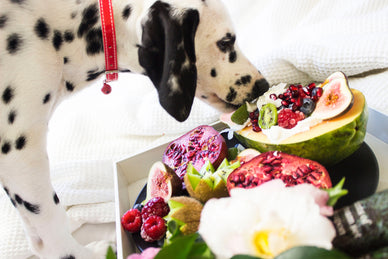
10 things your dog should not eat
Most dogs love to eat, and will eat anything that crosses their path. Although they do their utmost to fish something out of your plate, you better stop them! Not everything that is good for us is automatically good for your four-legged friend... That is why we would like to list 10 things that you should definitely not give your dog!
1. Chocolate
You probably already knew about this one. Chocolate is a real treat for us, but not for your dog. Although it may taste good to them, it does not always lead to happiness for your dog. Eating chocolate can cause vomiting, muscle tremors, cardiac arrhythmia, epileptic seizures and in severe cases can even lead to death. Not recommended!
2. Grapes & raisins
For both dogs and cats, it is not a good idea to serve them grapes or raisins. Even in small amounts, these can cause kidney failure.
3. Dairy Products
Did you know that most dogs are lactose intolerant? You can notice this quickly, after eating dairy products they may have thin stools or even diarrhea.
4. Onion
Onion in large quantities also does not do much good for your dog's body. They provide a large breakdown of red blood cells, resulting in anemia.
PS. Garlic, leek and chives have the same effect!
5. Avocado
Avocado is omnipresent the last few years, enormously popular with the people but again no spit for your dog's mouth! The substance "persin" that is well represented in an avocado, toxic not only for your dog but for virtually all animals. It causes subcutaneous water retention and heart failure with a risk of death. So better not share your avocado!
6. Nuts
The high fat content of nuts can cause stomach problems in your dog. Some nuts are also an absolute no-go - highly toxic - for your dog such as pecan nuts, macadamia nuts, almonds and walnuts!
7. Raw potatoes
Just like avocados, raw potatoes contain a certain substance that dogs can't tolerate: solanine. Eating solanine can lead to gastroenteritis, apathy and in severe cases can even lead to coma.
8. Raw fish
Better keep your sushi to yourself after all! Raw fish can give your dog neurological symptoms!
9. Chicken or turkey bones
Gnawing on a bone, that must be one of the favorite activities of every dog! Yet you better think twice before giving such a bone. Bones of poultry are actually not a good idea at all. They are too small so they can choke, and they can splinter or have sharp edges that can cause damage to the stomach and intestinal walls.
10. Brussels sprouts
Your children are not fans of them but neither is your dog! Because of the harmful substance 'isothiocynate' they can develop stomach problems which can also cause some more 'gas problems'. So don't eat those Brussels sprouts. Your kids, your dog and your nose will thank you!
This list could go on and on. As you can see, your dog is not made to eat with his owners. Keep it for them rather on their tasty kibble and reward them every now and then with a delicious treat or chew!
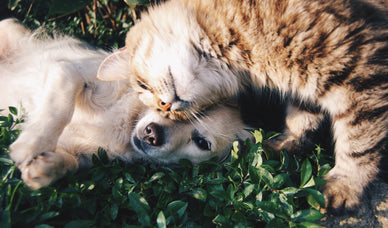
How do you introduce your dog and cat to each other?
The myth that dogs & cats are each other's natural enemies and that their typical body language is unintelligible to each other is in between already outdated. Well socialized dogs and cats can live in perfect harmony with each other. Better yet, some even become inseparable friends! Yet you better give them a hand to make the acquaintance as smooth as possible.
Would you also like to bring a new four-legged friend into your home with your dog or cat? Then read our tips for a responsible introduction between your 2 new friends.
Preparation
Do you already have a dog at home? First take him for a long walk and let him chase his toys. This way he will lose most of his energy and his hunting instincts will be at a lower level.
Do you already have a cat? Make sure they are relaxed and in a familiar space. Don't give them any unnecessary stimuli beforehand. It is best to introduce your new pet at home because new environments can cause your cat a lot of stress. It is extremely important that both dog and cat feel completely at ease!
Note: Do not let the dog immediately at the cat box, this is private territory for your cat and they could be surly if the dog comes too close to their 'palace'.
Sniffing party
There will be a lot of new smells for your four-legged friends! Before you introduce them to each other, let them sniff you first. Through you, they can sniff each other's scent and this is kind of their first introduction.
Time to bring the animals into the house! But first place them separately in each a different room where they cannot see each other yet but can explore the space. Is this a success? Then switch them from one room to another. This way they can sniff out each other's scent again.
Tip: do not forget to reward your animals with treats. This way they associate the new smell with something positive!
The introduction
The moment has come, time for the introduction! Put your cat in a familiar basket or travel bag in a higher place. Keep your dog on a leash and put them at a distance from each other. This way they can have a good look at each other and calm down if they get a bit too enthusiastic. Is this going well? Then give them another reward!
Time for the next step. Let the leash of your dog a little looser and give your cat the opportunity to go where she wants. Make sure there is always an escape route for your cat to a higher place where it can oversee its surroundings. In any case, do not force your animals to greet each other. They set their own pace. Keep a friendly and sweet tone in your voice when you talk to them, that way it is an extra incentive to be friendly to each other.
Body language says it all
The body language of an animal speaks volumes. Does your cat lay its ears flat back and swish its tail back and forth? Then your cat is indicating that it is irritated. Does your dog keep quiet and fix his eyes on the cat? Then he is ready for the 'hunt'. Does he rather frequently lick his lips and yawn? Then he is stressed and feels uncomfortable.
Is your animal showing signs of irritation or discomfort? Have them focus on something else like a treat or take them to another room and try the introduction again at a later time.
Tip: Each time, make sure your own body language is relaxed as well. Animals immediately pick up on the slightest feeling of stress and often take over very quickly.
Patience is key
Introducing your cat and dog is not something you can do in one day. Start the introduction with a few minutes every day and do this a little longer each day. Is everything going calmly and quietly? Then it's time to release both animals and let them get acquainted on their own. There are several scenarios. Some become best friends immediately, for others it takes weeks or even months and for some the spark never comes. Give them time and only leave them together under supervision. If after a few weeks they still do not manage to get along in a calm manner, you can seek help from an animal behaviorist.
Putting it al together
Don't put them together immediately but first let them get used to each other's scent
Reward calm and good behavior
Watch their and your own body language
Prevent stress factors
Do not force your animals to do anything
Good luck!
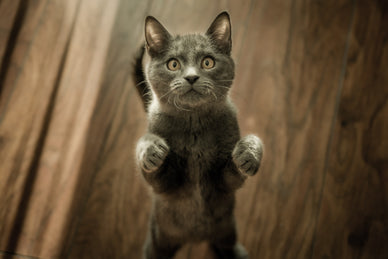
How to read your cat's body language
Your cat may meow from time to time but that is not their only way of communicating. They speak volumes with their body, facial expressions and posture. With our tips you will learn to recognize their body language better!
Body language
You can recognize a happy cat by its forward-pointing ears, tail that stands straight up with a possible curl at the top. If your cat spontaneously hollows its back, then they are extra relaxed.
Legend says... that you can reassure your cat via a wink. Put yourself in front of your cat and gently squeeze your eyes shut several times in a row and your cat will relax. Winking for a cat actually means that the coast is clear and that they can relax. Test it out on your own cat to see if the legend is true!
Are your cat's ears pointed and turned outward? Then there is a good chance that she is uncomfortable. If the ears lie rather flat against their head and the tail swings firmly from side to side, then she is angry or anxious and ready to defend herself.
Giving heads
Does your cat greet you by stroking your legs or giving you heads? Then they are marking you rather than greeting you. That way your cat leaves its scent on you, making your cat familiar with you. Does your cat want to 'really' greet you? Then they prefer to do this by giving you 'noses'.
A cat that is eager to make contact with you will draw up its stature with its tail. Your cat will also make soft meows, to get your attention.
Did you know that a cat meows for people? Cats meow among themselves a lot less often.
Emotions
Is your cat scared? Then its ears lie flat on the back of its neck. Your cat makes itself small and keeps low to the ground with the tail close to the body. The whiskers are also completely flat backwards.
Is your cat irritated? Then your cat will start waving its tail on the ground. At first, the waving is quiet because your cat is still indecisive at this time. If the waving continues, your cat will get more and more irritated. The more "tail waving," the more agitation in your cat. Best to stay out of this cat's way at that point.
Is your cat angry? Then your cat turns his ears outward, with the tail still waving. Does he make his back big and round and put his tail straight up? Then it's time to get out of the way because your cat is really very angry at the moment.
Is your cat in pain? Then you will not immediately see this from your cat. So it is very important that you learn to recognize your cat's subtle pain signals. A cat that feels pain will retreat to other than its usual spots. Often with his head between his shoulders and a huddled posture. If you notice such behavior, be sure to consult your veterinarian in this case.
A happy cat
A happy cat is easily recognized by its natural behavior. Pay attention to this behavior, because in this way you can easily determine when your cat is not feeling well and you can quickly create the right conditions so that your cat feels at his best!
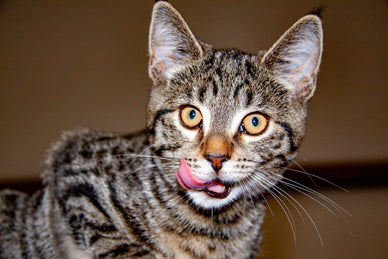
10 tips for a happy cat in the house!
Cats are special creatures and once you understand them well, you can make their lives a lot more fun! With these 10 tricks you can make your cat's days a little better every day!
A clean litter box
Make sure that a clean litter box is always available in a quiet place in your house. Cats are most vulnerable in the litter box and that is why you should make them feel safe. Failure to provide a clean litter box for your cat can cause your cat to lose their needs and cause physical problems.
high spots
Have you noticed that your cat is always looking for a place on top of the cupboards or fridge? This is because a cat likes to see its environment from a high place, so your cat has a clear overview of where the 'danger' can come. Provide a high scratching post or attach a piece of plank to your walls with, for example, a soft carpet in it. This way your cat can relax on its own throne in the air!
Provide an indoor jungle
Cats often love to walk past plants, play, etc. Many cat owners can confirm that a houseplant here and there dares to die with a cat nearby. NB! Several houseplants are poisonous to cats. Read all about it in this blog.
Accept your cat's character
Not every cat has the same character. One loves nothing more than to be cuddled while the other wants anything but to be picked up. It's important to respect when your cat wants your attention and when it doesn't. Even cats need a little me-time every now and then!
Some believe that you can knead a kitten in character, but usually this is not the case. The ideal way to teach your kitten desirable characteristics is to already have an adult cat in the house that already has those certain characteristics.
Leave your kitten with its mother long enough
Leave your kitten with its mother for at least 16 weeks. Also in nature, the mother only sends her kitten into nature from 16 weeks. Moreover, this only happens if there is not enough food for the kittens, otherwise they will stay with their mother for a few more weeks. If you remove the kitten earlier, you significantly increase the chance of later behavioral problems. They learn from the age of 8 weeks what it is to be a 'cat'. If you isolate a kitten at that time and do not let these things learn from another cat, you will end up with a socially less strong and very anxious cat.
Provide quiet places
A cat is independent and likes to have the freedom to go where she wants. When it becomes too busy for them in the house (because of visitors, vacuum cleaner, too loud TV, ...), make sure that your cat can quickly flee to a safe place in the house for him. Your cat will thank you!
Keep their food and toilet separate
Cats naturally do not defecate near their food for hygienic reasons. Make sure their food and water bowls are not in the same area of the litter box.
Adapted nutrition
Feed your cat food that is adapted to its needs. Within Delcon we developed ranges that contain food for the complete life cycle of your cat. Inside the Heritage gamma we have balanced and complete varieties of cat food, each rich in quality ingredients, multivitamins and essential minerals. In addition to this range, there is a second range, the Which range, focusing more closely on special needs that cats often have. Wondering which food suits your cat best? Try our productfinder from!
playmate
Cats are social animals and like to interact with other cats. Are you bringing a kitten into your home? Consider getting two from the same litter as they are already used to and bonded to each other. If you already have a cat, look for a cat that suits your cat well in terms of character. Playful cats cause stress in previous lazy cats. Or eg older cats are not immediately waiting for a playful kitten. If you do bring in a second cat, introduce them to each other gradually. And finally, make sure each cat has its own stuff!
reading body language
Finally, keep an eye on your cat's body language. Your cat will feel understood and happier. Pay close attention to how your cat behaves and you will better understand what your cat wants. Because strangely enough, your cat shows a lot through its body language, read it here everything about!
The more understanding and trust between cat and owner, the happier your cat will be!
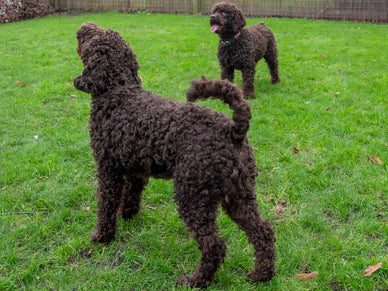
An extra dog in the house, now what?
The more the merrier. A slogan that sounds quite familiar to you. This can apply to both humans and dogs. A new playmate at first seems like nothing but roses and moons, but the reality is that it is the other way around. But with good preparation, you are already one step ahead of that negative reality!
TIP: NEVER take a second dog if you are already short of time for your first dog. It may seem like the ideal solution for both dogs to be able to entertain each other during the hours when they are alone at home. Yet nothing could be further from the truth, this is rather a recipe for misery. Your newest dog will have difficulties in training, especially when it comes to listening to his owner and the two dogs will be more fond of each other than their owner. So think before you start!
Does your dog agree to this?
A second (or maybe even third, fourth or fifth) dog in the house, your current dog may like this very much or nothing at all. Not every dog is eager for a new four-legged friend in the house. Some dogs have a stronger "pack feeling" than others and you should always respect this.
Risk
Suddenly a new puppy in the house can pose a risk. In the eyes of your current dog, there is suddenly an intruder in the house with whom he has to share everything for the rest of his days. Although this is not always the case, some matches are better than others. It is often recommended to put a male and a female together, which does not alter the fact that both 2 males and 2 females can get along perfectly. The best way to find the ideal match is to see if their energies match.
First impression
Have the first encounter in a neutral place with both dogs on a leash. Take a walk with the dogs together and always reward good behavior, so you create a group feeling for them between the two. After the walk, go into your house with both dogs.
first weeks
The first weeks are always the hardest, everyone is trying to find their way in the new home situation and this can sometimes cause some fireworks. It is best to take some measures to avoid troubles. Like giving each their own toys or taking them away for the initial period. If you feel tension between the two dogs, separate them for a while. Also give each dog its own sleeping place with a basket and its own food bowl.
Body language
Dogs need structure, especially if they live with several people. Times when they are being chased (such as the moment just before they eat, or for a walk, etc.) can sometimes be the perfect excuse to set both dogs on fire at each other. So always avoid such a moment by keeping a close eye on their body language. Do you see one of the dogs getting agitated? Send your dogs back to their place until things calm down.
Double trouble
If you take a second dog (or maybe a third, fourth or fifth dog yourself), take the consequences into account. Multiple dogs in the house also means twice as much dog hair in the house, twice as much dog supplies, double vet costs, etc. A dog that comes into your life usually stays there for 10 to 15 years. Keep in mind whether your dog fits into your future plans. Adding a dog costs time and money but brings you back so much more. An extra dog immediately provides that extra portion of dog love!
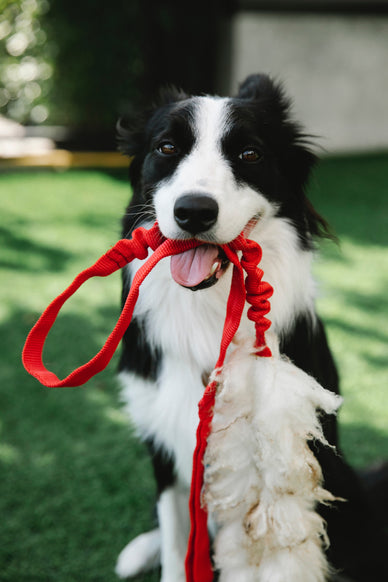
Teach your dog to walk on a loose leash
Are you also tired of your dog pulling on the leash? Then the following tips are the perfect read for you! We will help you teach your dog to walk on a loose leash. With the help of our tips, you will have the job done in no time. A nice and relaxed walk with your four-legged friend is now also your reality!
Why does my dog pull on the leash?
That your dog pulls on the leash is not without reason. It is important to realize for what reason your dog pulls so much on the walk.
There are several reasons but we can categorize them into 4 main ones:
Too enthusiastic
Your dog is sitting with some pent up energy. This pent up energy could be because your dog didn't have an outlet or he never learned how to deal with his energy properly. Because of that pent up energy you get an overexcited dog, where you don't stand a chance if he commands something.
Tip: the solution to this? Play with your dog for 15 minutes before you go for a walk.
Your dog knows it is working
This is actually one of the most common reasons... Your dog simply knows that if he pulls on his leash, he can maintain his own walking pace and that this way he will reach the place he wants to go faster.
As a reaction to an emotion
Your dog has a reaction to the environment - this can be both positive and negative. For example, they pass a place where they have once been frightened very hard, then they prefer to pass by that place as quickly as possible to get away. Or they see another dog, and pull towards it to play. Notice how your dog loses his focus in such situations? Then distract them with a treat. That way you, the owner, have their full attention and you can pass by that one specific spot.
Fright or stress
If you come into a new environment, then there is a chance that your dog experiences stress and pulls to find a safe place as quickly as possible.
Walking on the loose leash
The purpose of walking on a loose leash is that your dog maintains the same pace as you. Walking this way is the most pleasant for both you and your dog since there is no tension on his collar.
There are no written rules concerning where exactly your dog must walk, some people have gladly that their dog walks beside their side whereas others have no preference at all in this. There is no right or wrong in this case.
But let us nevertheless clear up a persistent misunderstanding. If your dog walks in front of you, this does not mean that your dog feels 'above you'. Because did you know that in their packs, it is perfectly normal for the leader to walk all the way behind? This way they have an easy overview of the pack. So don't worry if your dog walks ahead of you, but of course the leash must remain relaxed at all times.
How do you obtain that loose leash?
The main reason why your dog pulls on the leash is because they have lost contact with their owner. Therefore, practice mainly in paying attention to each other and preferably doing that yourself without a leash!
Go to a safe and enclosed field and lure your dog with a treat and an enthusiastic voice.
Tip: never give a tug on the leash when your dog pulls. Many owners have this as a reaction but it does not work! In fact... it makes the pulling even worse. Keep your leash relaxed at all times. Does your dog still pull on the leash? Stand still and only continue when he releases the tension.
Step-by-step plan for walking without pulling on the leash:
Find a safe, enclosed field where there are as few distractions as possible and make sure you are provided with your dog's favorite snacks (make sure you have enough with you)
Take your dog on a leash, give a start signal (such as 'yes' or 'walk') and begin your walk. Reward your dog when he walks with you (without pulling on the leash of course)
Keep walking in circles or back and forth. Still reward your dog if he continues to follow you.
Is your dog pulling on the leash? Then stop walking immediately. Make sure your dog releases the tension on the leash and then step back on.
If this works in the 'distraction-free environment'. Then go step by step to environments with more distractions walking
Once you can manage to walk without pulling in the new environment, it is time to switch back to more challenging environments.
How long does it take for your dog to walk on a loose leash?
It can take quite a while to teach a dog to do this. Especially for puppies who have yet to discover the world, it can be a real chore.
1 golden rule: Train regularly, be consistent but keep it short!
Training sessions should not last longer than 5 minutes each time (best also 2 to 3 sessions per day). The more you practice, the faster you will see results. Take some time during your walk to train this. Sufficient patience is a good virtue, because an angry or frustrated boss will not help your dog during his training!
Sidenote: You have a faster chance of success in teaching a puppy than a senior dog of 8 years. Which is not to say that it is impossible to teach an older dog to pull on a leash. The message remains again that you need a lot of patience and practice, you are training to unlearn 8 years of "pulling history" of course!
Harness or leash?
The eternal dilemma. You have advocates of the leash and you have advocates of the harness. But where is the difference?
A collar says it all: a band that only goes around your dog's neck. The advantage of this is that his body is not obstructed while walking. Your dog has thus less chance to get stuck somewhere. The disadvantages of a collar are that there are many vital organs around the neck. If your dog pulls hard on the leash, this can lead to injuries such as damage to the larynx and trachea, headaches and even displaced cervical vertebrae. All the more reason to teach your dog not to pull on the leash of course ;) . The dog harness goes around your dog's chest and thus distributes the pressure your dog feels when he pulls. The disadvantage of the harness is that it can impede your dog's range of motion....
Dogs pull on both types so one or the other does not offer a miraculous solution to stop pulling. So it's best to take what your dog is most comfortable with.
In summary: tips for relaxed walks
Use every possible moment to train your dog
Always make sure that you have enough treats with you during your walks so that you can reward your dog for good behavior
Make sure there are no distractions during your training. In other words, make sure your dog's other needs are met (like peeing, sniffing, playing)
Never punish your dog! Reward good behavior instead. Does your dog not do what you want? Ignore your dog and stand still. Only as soon as he is calm again or does what you ask, go ahead.
Never pull on the leash yourself because this will have the opposite effect!
Good luck!
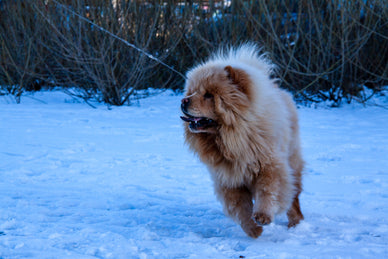
5 tips to get your dog safe and warm through the winter
We all feel it, the days are getting shorter and a whole lot colder. We immediately pull our winter coats out of the closet but our dogs do not have the advantage of deciding for themselves when they want to be a little warmer. How your dog reacts to the cold often depends on the breed. A husky feels like totally at home in the snow and cold, while a Vizsla would rather go back inside if he feels a drop of rain during his walk. The age of your dog plays a big factor. A puppy also finds the cold quite unpleasant because they can't get their tummy warm. With these handy tips, you can make sure that both you and your dog can get through the winter safely and warmly.
Avoid potential dangers
There are many dangers lurking in small corners during the winter. Pay particular attention to the following
Frozen water and ice: Never let your dog walk on ice. Your dog is not aware that that ice can break just like that. Thus, prevent drowning or hypothermia! Even if the ice is thick enough to walk on, avoid it. Your dog can quickly lose control and tear a muscle.
Antifreeze: Keep antifreeze away from your dog at all costs. Even a tiny bit of antifreeze in their system can be deadly. It is important to keep these items locked away.
Take a walk during the day instead of in the evening or morning
Not always obvious now that the days are a lot shorter but it is the safest option to plan your walk during the day. In the morning and evening the visibility is a lot lower, there is ice in many places and drivers do not always see you coming.
If you have no choice but to hike in the dark. Take precautions. Provide your dog with a jacket, possibly shoes if necessary, a luminous leash and possibly an extra light for their jacket. Provide a fluorescent jacket for yourself as well.
Give your dog a jacket
Puppies and senior dogs can't stand the cold as they have less muscle and fat than an adult dog. Muscle and fat present in your dog's body increases their metabolism and keeps them warm. A puppy's coat is also important not yet thick enough to provide protection and warmth. They therefore benefit most from wearing a jacket.
Protect the paws
It looks strange and the first time you put it on, they often don't like it. Still, it's highly recommended to provide your dog with a boot or "sock" if it's very cold or if you're walking in the snow. Otherwise, there is a good chance that they will suffer from leg or foot pad discomfort.
If you decide not to wear boots, be especially careful with small snow or ice balls between your dog's toes or in his hair. When you get home, it is best to clean his paws and let them warm up again. If you do not do this, they will lick their paws dry themselves and absorb the road salt, which in turn can cause irritation.
Keep your dog close while walking
Keep your dog on a leash during your 'snow walk'. Why? Because dogs tend to lose their way in the snow, their entire walk is covered is a layer of snow so everything looks the same. Even during your daily walk in the same forest, your dog may become slightly disoriented. The cold environment gives off a lot fewer scents than during the warmer months, which makes it harder for your dog to pick them up.
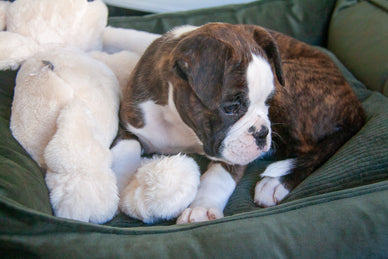
Cold & dark days: what to do with your dog during the winter?
Now that the days are short and cold, sometimes it's an easier option to get your dog tired and satisfied indoors in a fun way. But what can you trade with a walk? With our 4 tips, you'll get your dog tapped out in no time.
Indoor activities with your dog, where to start?
During bad and cold weather, you can still easily set your dog physical and mental challenges. Dogs with little exercise or mentally challenged can exhibit dejected behavior to even scrapping behavior.
An outdoor walk is of course one of the important ways to let your dog loose his energy. But for variety you can certainly also give your dog an extra challenge indoors.
Did you know that: Playing together with your dog benefits your mutual bond enormously! It enriches the life of your dog.
TIP 1: Learn new tricks
A training session with your dog allows your dog to relax completely. Indoors, you can dedicate all your time to learning new tricks such as sit, lie, touch, turn, paw, ...
Provide here certainly a number of crucial elements such as a solid surface so that your dog does not slip during practice. Be sure to keep some treats handy, a reward after performing a new exercise correctly always helps. And keep your training always fun and simple, practice so certainly not too long! A few minutes at a time a number of times throughout the day is more than enough. Does your dog enjoy it? Then you can increase the training minutes a bit.
TIP 2: 'Feeding enrichment'.
Feeding your dog in an original way helps activate your dog's instincts. On top of that, it also makes your dog eat less, which is good for digestion.
There are several ways to feed your dog in a creative way, such as putting his food in a KONG, you can put the pellets on a towel, roll it up and tie it, sprinkle the dog food on a sniffing mat or use a slowfeeder. These ways of feeding will put your dog's brain to work!
TIP 3: Play games with your dog
Indoors, there is also plenty of opportunity to play fun games with your dog. You can for example hide candies throughout the house, this way you bring out the hunting instincts of your dog. You can go a step further and hide yourself in your house while someone else distracts your dog. Your dog will love tracking you down with his nose.
Rope pulling also remains one of every dog's favorite games. Be sure to balance and provide enough resistance to keep the game interesting and fun but stop in time if your dog becomes hyperactive.
TIP 4: Puzzles
"Puzzles for dogs?", I can already hear you thinking! There is now a whole series of puzzles made especially for dogs. A dog puzzle requires your dog to concentrate and put his nose and head to work. Thinking sports are often underestimated but they make your dog tired and satisfied in a fun way. Definitely not to be underestimated!
& remember: always keep a tasty dog treat or chew at hand to reward dog for good behavior. The more you reward good behavior in time, the faster your dog learns it!
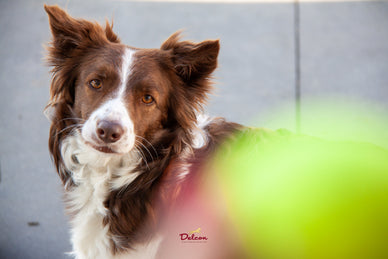
Mind games for your dog, the optimal use of time
That a dog can smell much better than a human, you probably already knew. That a dog chases his nose is therefore only natural. Your dog likes to put his nose to work! Brainwork for your dog through mind games and sniffing games stimulates your dog's brain, gives them a satisfied feeling and on top of that creates a better bond with its owner. Definitely worth a try, right?
How do you start?
You don't necessarily have to buy games from the store. You can use the household items you have at home to create a fantastic game for your dog! Empty bottles, cardboard boxes, old pieces of fabric, silicone baking mold, ... you name it and you can turn it into something you can entertain your dog with. Just about anything is suitable for hiding a tasty dog treat in or under (as long as the material is safe for your dog, of course).
Example: Let your creativity loose and make your own sniffing mat from old pieces of fabric you have lying around. Hide some dog treats in it and let your dog sniff around on it. Or fill a cardboard box with empty toilet rolls and spread out his tasty dog treats in it.
The purpose of dog games
Brain work for your dog offers numerous benefits. It helps your dog's concentration, brings his energy level down, but the benefit that jumps out at the top is the fact that it stimulates your dog's brain. Instead of putting their muscles to work (in e.g. a pull-rope game), you now put their nose to work tracking down certain things. Which is great for your doggie, it makes them feel fulfilled. Make regular brain games part of your dog's weekly routine, it will keep your dog's thinking skills sharp.
Connection
Besides being a stimulus for your dog's brain, it also helps your dog get rid of his energy. But don't get us wrong, it's obviously a different kind of fatigue than after a big walk. Dogs need both physical and mental challenges! Within the physical and mental challenge, the connection with the owner is also key. By working and playing together, you will get to know your dog more closely and see how he handles solving 'problems' or puzzles. That way you can quickly work further on things your dog enjoys doing.
Puzzling for everyone
Brainwork is for every kind of dog, if it is properly shown to the dog. The game should be tailored to your dog's needs. Feeding from a KONG that requires the dog to lick and chew is soothing. Whereas feeding in a food ball is more likely to provide more energy. Do you have a dog that needs more exercise? Then a food ball is more likely to be the right choice for you. Does your dog need to calm down for any reason (such as an operation)? Then mind games are also the ideal solution to keep them active and occupied.
Time to get a brain game in the house!
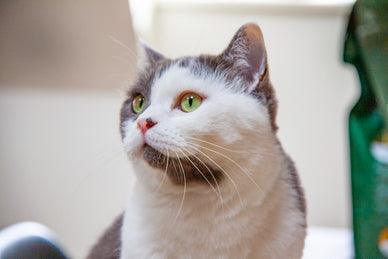
How old is your cat really?
That a cat or dog does not live to be 70 years old is generally known. But how old is a cat in human years? Often the rule is brought up that you have to multiply their age by 7 to calculate the age in human years. But actually this is not entirely accurate. Did you know.
Age of your cat in human years.
The fact that you would like to convert your cat's age into human years is not surprising. After all, it helps you understand what your pet's behavior means and what health risks you need to consider. If you multiply the age of your cat, as is often said, by 7, then you are not taking into account a lot of aspects that do have an effect on the health of your cat.
One helpful tip we'll give you: Equate the end of your cat's first year of life to 15 human years and the end of its second year of life to 24 human years. After that you add 4 human years each time so it goes as follows
Child (birth - 4 months)
0 - 1 month (cat) = 1 year (human)
2 month = 2 years
3 month = 4 years
4 month = 6 years
Junior (5 month - 1 year)
5 months = 8 years
6 months = 10 years
7 months = 12 years
12 months = 15 years
Adult (1 - 6 years)
18 months = 21 years
2 years = 24 years
3 years = 28 years
4 years = 32 years
5 years = 36 years
6 years = 40 years
Senior (7-10 years)
7 years = 44 years
8 years = 48 years
9 years = 52 years
10 years = 56 years
Senior (11-14 years)
11 years = 60 years
12 years = 64 years
13 years = 68 years
Age 14 years = 72 years
Senior (15 years and older)
15 years = 76 years
16 years = 80 years
Age 17 = 84 years
18 years = 88 years
19 years = 92 years
20 years = 96 years
21 years = 100 years
6 stages of life of your cat
As you can see, there are 6 stages in the life of a cat depending on its age. These 6 stages have an effect on the development of your cat and its health.
Child: 0 to 4 months
Your kitten grows and develops very quickly
Best nutrition: Delcon kitten
Junior: 5 months to 1 year
Your cat is fully grown and learns many things in its environment such as how to behave
Best nutrition: Delcon kitten
Adult: 1 year to 6 years
Your cat is now fully grown and is generally healthy and active.
Best nutrition: Delcon Adult with fish, Delcon Adult rich in Chicken, Delcon Sensitive with Lamb, Delcon Sterilized, Delcon Urinary
Senior: 7 years to 10 years
As soon as your cat reaches the age of 7, you have a real senior running around the house. Now they have an increased risk of aging diseases such as arthritis or kidney disease. From the age of 7 you should visit the vet regularly or at least have a yearly health check done by the vet.
Best nutrition: Delcon Senior, Delcon Sensitive with Lamb, Delcon Sterilized, Delcon Urinary
Old age: 11 years to 14 years
From the age of 11 your cat has an increased risk of health problems. Cats also don't often show when they are suffering from something. Visit your veterinarian regularly to make sure your cat is not having any discomfort.
Best nutrition: Delcon Senior, Delcon Sensitive with Lamb, Delcon Sterilized, Delcon Urinary
Senior citizens: 15 years and older
Give your cat a happy old age with the highest possible quality of life. Have your veterinarian monitor your cat's health preferably every quarter
Best nutrition: Delcon Senior, Delcon Sensitive with Lamb, Delcon Sterilized, Delcon Urinary
Annual checkup at the vet
As you've read above, cats can develop serious health problems starting at age 7. & cats are masters at hiding their pain or discomfort. Therefore, it is important to recognize signs of pain and be aware that not every condition is immediately visible in a cat. A periodic or at least annual checkup at the veterinarian can help address unpleasant ailments or diseases early. That recurring checkup is recommended if your cat is 7 years old or older. Do you doubt that something is wrong with your cat? Then it is best to contact your veterinarian immediately.
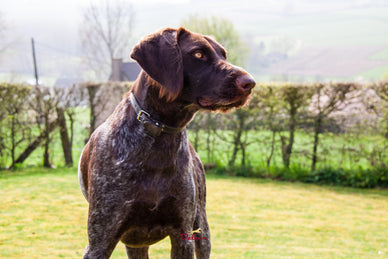
Paying attention during the spring and summer days
FINALLY, the dark days are behind us and spring is here like never before. Warmer temperatures and longer days. Two things that can please everyone, owners and pets alike. Yet those spring and summer days bring with them a few woes here and there. But a forewarned man is worth two. Read our tips on how to combat those ailments here.
#1: Beware of hogweed
Bear claw, what exactly is that! Hear me think to you already. Well, here is a type of plant that everyone has encountered on a walk through a forest. This plant can be recognized by their white inflorescences and large hairy bracts. The plant is often found along the water's edge or on the roadsides. And why exactly should you be wary of this? That's because the sap of a hogweed is poisonous and makes the skin very sensitive. Does your dog in contact with that juice? Then after 1 day he gets all kinds of red, itchy spots on his skin. Those spots can turn into blisters that look like real burns.
How do you deal with this?
Get your dog out of sunlight as soon as possible and rinse the exposed areas with lukewarm water. To be on the safe side, also contact your veterinarian. The healing process takes about 1 to 2 weeks on average.
Tip: If you see this plant growing in a dog walking area or a place where animals frequent, you can report it to the municipality to have the plant removed.
#2: Make sure your dog's vaccinations are up to date
Warm and humid weather is a dream scenario for parasites. Better to prevent than to fight, so make sure your pets are dewormed on time, protected from fleas, etc. It is critical that you always purchase these products from your veterinarian or pet store. Other stores have too little knowledge to give you enough information.
#3: Together with the spring starts the 'tick-season'.
As soon as the temperature rises above 8 degrees, the tick is back there too. From March to October it is important to be extra vigilant for these nasty creatures. Nowadays, there are fortunately pills that you can administer to your dog every 3 months and which protect them against tick bites. Feel free to ask your veterinarian for information on this.
But whether you give medication or not, it is still a good idea to check your dog for ticks after every walk. On average, a tick only establishes itself after 24 hours. So check your dog after every walk, you will save yourself a lot of misery by catching the insects in time.
#4 Beware of blue-green algae
You may not have heard of it but that doesn't make it any less toxic. Blue-green algae are very small organisms that live in fresh and stagnant water and mainly surface during warm temperatures (from May to September). These blue-green algae secrete toxic substances that cause irritation and nausea. You or your dog can become infected by ingesting contaminated water. Dogs often get infected by licking their fur clean after swimming in contaminated water.
You can recognize such blue-green algae by their color, which varies from very light blue to green, turquoise and sometimes even reddish brown and they spread in floating "flakes" in the water. Often there is also a message from the municipality if blue-green algae is present somewhere in the water.
Are you or your dog infected with the blue-green algae? Then there may be symptoms of irritation to the eyes, skin, headache, nausea and fever for 5 days. It is best to contact your veterinarian if you see these symptoms in your dog.
#5: Don't let your dog run after insects
Does your dog or cat dare to chase a wasp already? If so, call them back to you quickly anyway. Because just about every animal is allergic to the chemicals in the sting of insects. This means that if they are stung by an insect, that place immediately begins to swell. If this happens near the face, it can lead to breathing problems (especially if stung in the throat or tongue). If you see swelling coming up, first see if you can see the sting & then go to the vet as soon as possible.#6: Help your dog get rid of his winter coat
Temperatures are rising so our winter coat may go back into the closet. This applies to us but also to our pets. As soon as the days get warmer, your pet will want to get rid of his winter coat as soon as possible. You can help your dogs with that, fortunately. Brush your dog daily, and then go over his coat with a wet cloth. This way you stimulate the 'shedding process' and prevent the dead hairs from sticking together.
#7: Your pet can also suffer from hay fever, unfortunately....
During the period from March to October, many people suffer from hay fever. But this hay fever does not only occur in humans but also in animals. It only manifests itself differently in animals than in humans. Dogs do not sneeze or have a runny nose, they rather get an itch which they scratch. This in turn can lead to coat problems.
How do you recognize hay fever in your pet?
Itching around the face, mainly at the muzzle or ears
Itching on the sides, armpits or back
Recurring ear infection
Irritation to the eyes (swollen and red)
Irritation of the soles of the feet
What can you do about this?
Adjust your dog's diet to one that is going to support his skin and coat. Foods like Delcon Regular Plus - Rich in Fish can help with this. In addition, make sure that his coat stays clean and that no pollen or other dirt is left in his coat.
Also, discuss it with your veterinarian. A skin allergy test can be done to see what your dog is allergic to. That way, your vet can prescribe medication if necessary.
#8: Take the heat into account
Did you know that dogs get really hot at 20°C? So don't go doing active things (like walking, running or cycling) with your dog at such temperatures, because there is a good chance your dog will overheat. Give him enough rest and shade during hot days. This is because a dog that is overheated has a much harder time getting rid of heat than humans. This can even lead to a fatal outcome in dogs.
And it is already shouted from the rooftops but still we find it so important to repeat again: NEVER LEAVE YOUR DOG ALONE IN THE CAR IN WARM TEMPERATURES. The temperature in a car can easily rise to 50 to 60°C in 10 minutes and your dog will not survive that. Even leaving the window ajar or parking your car in the shade won't help!
So, with these tips you can fully enjoy (and be prepared for) the wonderful spring days together with your beloved pets.
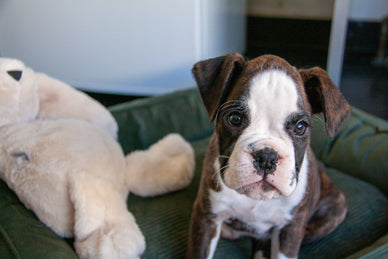
New puppy in the house: now what?
Have you been looking forward to the homecoming of your new puppy for weeks (or who knows months or years)? Then the days probably can't move forward fast enough for you. But it is still of great importance to make sure that you are optimally prepared for this big day. The transition from their litter and their mom to a new home on their own takes a lot out of our little four-legged friends.
But don't panic, with these tips you will already make it a lot easier for your pup.
Make it as comfortable as possible
Put your puppy's basket in a cozy and quiet corner. Put a pillow and possibly a cuddly toy in that basket where your pup can nestle against it when they need it. Buy the basket not at the smallest because your puppy will soon get solid growth spurt and then you can equal its first basket in the trash.
Tip: ask the breeder a few days before picking up the pup if you can put a cuddly toy in the litter. That cuddly toy will take over the smell of the litter. Put it in the basket of your pup once it is at home. This will provide some reassurance to your pup.
Make it as comfortable as possible
Put your puppy's basket in a cozy and quiet corner. Put a pillow and possibly a cuddly toy in that basket where your pup can nestle against it when they need it. Buy the basket not at the smallest because your puppy will soon get solid growth spurt and then you can equal its first basket in the trash.
Tip: ask the breeder a few days before picking up the pup if you can put a cuddly toy in the litter. That cuddly toy will take over the smell of the litter. Put it in the basket of your pup once it is at home. This will provide some reassurance to your pup.
If your puppy is now over 7 months old, it is better to switch from puppy chunks to junior chunks. This will provide the perfect transition to switch to adult dog food.
Delcon Junior supports your puppy in building muscle mass in the right way, it also ensures that the constitution and joints take on the final shape in a balanced way.
Ensure good health
Your puppy is very vulnerable in the beginning. Make sure you take the necessary measures to protect your puppy from as many parasites as possible. If you notice that your puppy is not feeling 100%, do not hesitate to contact your vet.
Make your house puppy proof
Puppies are just like babies. Everything that comes their way is interesting and should be checked out up close. Make sure you can provide a safe new home for your dog and keep the following items in the danger zone:
- Fragile items
- Electronic wiring
- Do not leave things lying around that are easy for a puppy to eat (stockings, jewelry, children's toys, etc.)
- Store laundry detergents and other chemicals properly
- Be sure to screen off your pool
- Be careful with poisonous plants such as azaleas, yews, ivy, etc.
Routine
Believe it or not but your dog benefits tremendously from routine in daily life. This routine will make it easier for you to teach them things.
Now what do I mean by such a routine, I hear you already thinking! Well, with this I mean that you give your pup for example 3x a day at the same time and at the same place its food. Or at the same time (and the same place) goes outside for a pee.
Apply these tips and make the homecoming for your pup and for yourself already a lot easier!
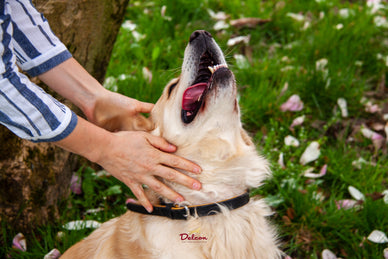
Guide: tick week (25-29/04)
Ticks, you may have heard of these nasty critters. They prefer to live in green areas, such as forests, gardens, dunes, parks, meadows, etc. They are present pretty much all year round but are only really active between March and October or when the temperature goes above 10 degrees. In other words, the insects are at work again and that's why we would like to give you some tips because a tick bite is not always without consequences!
What is a tick?
A tick is a small parasite, which looks more like a "blood sucking" spider. They crawl into the fur of your four-legged friend, looking for a place where they can nest and then feed on the blood of their host. They often attach themselves to the neck, ears, head or legs of your dog but they can of course be somewhere else (so always do a thorough check). A tick is initially not much bigger than 1-3 mm but once they have filled up with blood they can swell to 1 cm.
Can you get sick from a tick bite?
A tick bite is often harmless and painless. It only becomes dangerous if that tick is infected with a bacterium that can make your pet sick. The tick first looks for a good spot on the skin and before sucking blood, it injects a kind of liquid into its victim. This injection can cause certain diseases to enter the bloodstream.
A tick can therefore certainly be dangerous for your dog but also for yourself as well as for other (domestic) animals.
Diseases
Ticks can transmit several diseases that can make your pets sick. One of the most well-known diseases that can be transmitted is Lyme disease.
Lyme disease
The most well-known disease is Lyme disease, 1 in 5 ticks is infected with this bacteria. As soon as a tick that is infected with this bacterium settles in the skin and reaches the bloodstream, you can become infected.
TIP: Check your dog daily for ticks, that way you are there as soon as possible to remove the tick and reduce the risk of infection.
Is the tick already there for a longer period of time? Then pay attention to the following symptoms:
Joint inflammation that manifests itself in sudden lameness and pain in the joints
Fever
Loss of appetite
Fatigue
Dehydration
Swollen lymph nodes
Notice any of the following symptoms after a tick bite? If so, be sure to visit your veterinarian. Lyme disease is curable provided you treat your dog properly with a course of antibiotics in the first week of the illness.
Lyme disease is by no means the only disease they can transmit
Babesiosis
Lesser known disease but no less important to be aware of is Babesiosis disease. This disease is less common because it can only be transmitted by 2 species of ticks, one of which is the Dermacentor reticulatus. The Dermacentor reticulatus is a very nasty animal, it is often called the "dog killer" because dogs that are infected with it and not treated, almost all die from it.
Once the tick has attached itself, it takes about 3 days for the bacteria to enter the bloodstream. Is the tick there for a longer period anyway? Then watch for the following symptoms:
Itching and irritation where the tick is located
Inflammation of the skin
Fever
Little or no appetite
Vomiting
Pale or yellow mucous membranes
Red discolored urine
Dog can also go into shock
If you notice any of these symptoms, get to the vet quickly. Babiosis is not always fatal but you must be quick to start treatment. It often also leaves chronic symptoms such as increased heart rate, swollen lymph nodes, anemia, ...
How to prevent such a tick bite
Check your pet
After every walk or playtime in the garden it is best to give your dog a firm check. This over all his body but pay extra attention around the ears, head, neck, under the tail, between the legs and toes.
TIP: If you're lucky and the tick hasn't attached itself to the skin yet, you can go over your dog's coat with a clothes roller and the ticks will stick to it. Pretty handy!
Prevention is better than cure
There are already several ways to protect your pet from ticks, from pipettes to sprays, bands and medication. Check with your veterinarian to see which remedy is best for your pet, and that way make sure you're ahead of the scary critters and their ilk! But beware! No product works 100%. So keep checking your pet for ticks and remove them as soon as possible.
Still bitten by a tick?
If the tick has nevertheless attached itself to the skin, then the best way to remove it is with a special tick remover. Grab the tick as close to the skin as possible and carefully twist or slide it out of the skin. This loosens the mouth of the tick, allowing you to remove it easily. Still, don't pull too hard on the body, or the head of the tick will remain attached. Contrary to what many people think, this is not such a big problem. The head can be compared to a splinter, which will eventually fall out on its own. But keep an eye on the place, so that no infection occurs.
TIP: Definitely don't believe the fables! Do not use alcohol, heat or soap before removing a tick. The tick can then spit out its stomach contents into your dog's bloodstream and transmit disease more quickly that way.
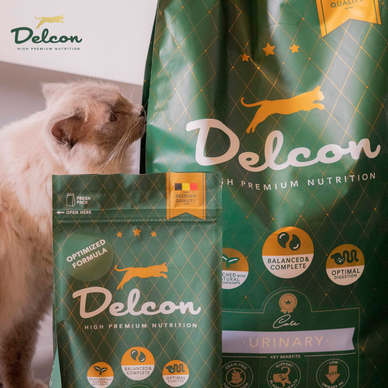
SOS: bladder problems in your cat
Bladder problems in cats are more common than you think. Suddenly finding pee in the house or seeing that your cat has difficulty urinating are typical examples of such a bladder problem. Very uncomfortable for your cat but fortunately quickly remedied. So best not to wait too long to intervene.
Cause of cystitis?
You're probably wondering why your cat has these problems, how quickly they heal and how you can best help. Today we are going to provide you with an answer.
In dogs, cystitis is caused by bacteria so you automatically assume that this is also the case with cats. Yet this is not true. In up to 70% of cats suffering from a bladder infection, the cause is virtually unknown and the infection goes away on its own. Presumably stress is a major factor in the inflammation.
In the remaining 30% of cats with cystitis the biggest factor is stones. These two phenomena occur mainly because cats do not drink enough water. This increases the chance of grit or stones and consequently the chance of an inflammation in the bladder.
What exactly is cystitis?
Bladder powder is a collection of the various types of minerals present in a cat's urine. Does this concentration become too high? Then the body has difficulty excreting them and they turn into crystals. It is similar to fine sand, which starts to clump together and transform into large stones. Those stones then try to pee out but often they get stuck in their urinary tract, which can be very painful.
Which cat is at risk for a bladder infection?
Some cats are more at risk for a bladder infection than others. E.g. cats that are easily stressed, overweight cats, older cats, neutered males, cats that are fed poor nutrition, cats that don't drink enough, indoor cats, etc are more likely to suffer from inflammation.
How can you recognize a bladder infection?
Does your cat start behaving differently than usual, such as peeing in the house or having trouble urinating? If so, this may be a sign that your cat is running with a bladder infection. Do you see blood in your cat's urine? Then this also indicates an infection of the bladder.
Do you see any of these symptoms in your cat? Then it's best to contact your veterinarian as soon as possible. Because such a bladder infection can be quite painful for your pet.
How to prevent a bladder infection?
By following these tips you can help your cat to avoid such a painful cystitis.
Make sure your cat drinks enough
Cats generally find it hard to drink. It is best to provide fresh water each time to encourage them to drink enough. Because a cat that drinks enough also urinates more. The chance that cystitis or bladder stones get stuck somewhere (and cause an infection) is a lot smaller.
A cat drinks about 300ml per day, if it only gets dry food. Is your cat drinking less than the average? Then it's time to encourage your cat to drink more. You can do this by placing several drinking bowls in quiet spots throughout the house. Another way is to place a drinking fountain. Cats simply love to drink from running water. Thanks to that drinking fountain, they have continuous access to running water and so you encourage your cat to drink more.
Finally, cats who don't drink enough also benefit from wet food. Wet food helps dilute your cat's urine and thus automatically prevents the production of crystals.
Looking for wet food for cats? Discover our product range here!
Provide your cat with quality food
Giving the right food to your cat does wonders. Cats that live indoors, neutered cats or overweight cats are very susceptible to bladder infections. Adapted nutrition for them is obviously very important.
Cats that are overweight, or don't exercise a lot like indoor cats should be given food that is easily digestible like Delcon Sensitive with lamb.
Sterilized cats should be given food that is suitable for them, such as Delcon Sterilized. Thanks to the balanced minerals it helps to reduce the risk of urinary stones.
If your cat often suffers from bladder problems, you should switch to Delcon Urinary. This is specialized food to maintain the health of the urinary tract. This food provides less concentrated urine because of balanced minerals and a low pH of the urine. This reduces the chances of getting urinary stones.
Looking for dry food for cats? Discover our product range here!
Provide enough litter boxes and keep them clean
Provide enough litter boxes in your home. Provide 1 litter box per cat and 1 extra. Suppose you have 2 cats, then it is best to provide 3 litter boxes. Do you have one? Then it's best to have 2 litter boxes.
A clean litter box seems obvious but unfortunately it is not. Many owners really hate to clean the litter box. It is a task that we quickly postpone. But cats, of course, are not very happy about this. Is their litter box dirty? Then they quickly look for another place to do their business. Cats have a very strong smell so they are easily overwhelmed by strong odors. Do you smell the litter box, even though the lid is closed? Then it's time to clean it out.
Cats like to have enough places where they can do their business. This way they can pee enough and keep their bladder clean and healthy.
No stress
Stress is one of the biggest culprits when it comes to bladder infections. Avoidance is the message, but how do you do that? A cat likes structure in their daily life. Situations like traveling, boarding, having visitors over quickly send their structure into disarray. Try to keep stressful situations to a minimum and always make sure your cat has an 'escape route'. If things get too busy for your cat, it can flee to a place that is quieter for it.
How best to treat a bladder infection?
Have you been to the vet and they diagnosed your cat with a bladder infection? Then your cat may be given medication over the next few days. These will help your cat to recover. Yet it is also important that you make sure your cat lives in good health. It is certainly important that your cat gets the right food. We recommend that cats who suffer from frequent cystitis switch to a food that has been specially developed for this purpose, namely Delcon Urinary.
Want to know more about our healthy cat food that keeps your cat healthy? Take a look at our extensive range!

When do puppies switch to adult dog food?
Just as you don't give a baby a steak and French fries, you don't give an adult dog food. The needs of puppies are not on a par with adult dogs. Just as with people, the nutritional needs of a dog also depend on its age and those needs change over the years.
Tip: just as it is not a good idea to give a puppy adult dog food, it is also a very bad idea to continue giving an adult dog puppy food.
There is a big difference in nutrients between puppy food - junior dog food and adult dog food. Read all about the differences here and how to make the transition between the different foods as easy as possible.
Puppy food
Puppy food contains extra building blocks that support a stable growth of your puppy from the start. Delcon Puppy contains lots of proteins and fats which means it gives your puppy all the nutrients it needs to get through the first months of life in a healthy and balanced way and to build up the immunity system.
Opposite of adult dog food
While puppy food is packed with protein, calcium, phosphorus and the like, adult dog food is overloaded with other nutrients, minerals and vitamins that are less caloric. Therefore, it is in your dog's best interest that you match his diet to his age. Feeding an adult dog puppy food for too long can lead to obesity because it is such a high calorie food. Whereas if you feed a puppy adult dog food too early, this can trigger growth problems (which in turn can lead to bone and joint abnormalities).
Delcon Junior
To give your dog even better support while growing up, it is best to take another step between puppy and adult food, namely junior food.
Delcon Junior dog food is the perfect food for the transition from puppy food to a variety for adult dogs. In this phase of life it is very important to build up the muscle mass in the right way, and to make sure that the constitution and joints get their final shape in a balanced way. This pellet contains all the necessary nutrients to support growth in a stable way.
When should you switch from Delcon Puppy to Delcon Junior?
When your puppy arrives at your home he is - at the youngest - 8 weeks old. From then on you may feed your dog Delcon Puppy food. How long your puppy stays on puppy food depends on the size of his breed. Small breeds (like Chihuahuas) can be fed puppy food until they are 1 year old. Medium breeds (such as Boxers) until 8 months of age and large breeds (such as Bernese) you can switch to puppy food at 6 months.
Small breeds may be switched to adult food after 12 months.
When should you switch from Delcon Junior to Delcon Adult?
Has your dog reached the age of 15 to 18 months? Then it's time to switch to Adult dog food. Keep in mind, every dog is different. Some dogs are ready for adult food faster than others. Feel free to ask us your question to make sure it's the right time to switch.
What is the best way to make the switch?
Changing your dog's food from one day to the next is not a good idea. In that way you get the complete feeding pattern of your dog in the confusion. To let your dog get used to the new food, you mix that best with its current pellets. Do on day one 1/4 of the new pellets at your dog its food. The next day you do there again a quarter and so on. Notice you that the overschakeling not so smoothly runs for your dog? Then make the portion of the new food slightly smaller so that the overschakeling over a longer period runs. Thus can your dog quietly get used to its new delicious food!
Guidelines
New food means new feeding guidelines. Look certainly always good the food table at the back of the bag of food. & you can read it like this:
For puppies:
In the left table you will find the weight your puppy will have when it is an adult (e.g. a boxer puppy weighs about 25kg as an adult). Then you look at how old your puppy is at the moment, in the row below you can see how many meals your puppy can eat per day. Until they are 6 months old, divide the amount over 3 meals. Later you can switch to 2 meals. At recommended quantity you can see how many grams your pup can eat per DAY. Divide this amount over the number of meals your pup is allowed to eat.
For adult dogs:
In the table on the left you see the weight of your dog. In the first row on the right you see the activity level of your dog. Look at the weight of your dog and his activity level, how many grams your dog may eat per day. This weight you may then divide over 2 meals.
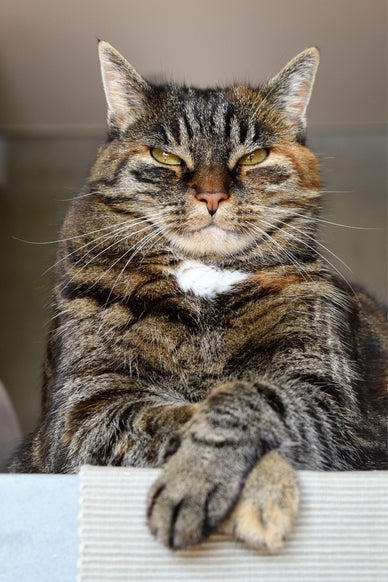
5 tips to take good care of your senior cat
Kittens need appropriate care but senior cats certainly do too. As your cat gets older, its behavior also changes. So keep in mind that your cat's condition will deteriorate and his senses will work less. So make it as comfortable as possible. You can do this with our 4 tips.
1. Keep a close eye on your cat
If you notice changes in their behavior, then it is best to find out what is going on. There are several things that can go wrong such as insufficient drinking, poor digestion, change in their coat, sleeping more, ...
As your cat gets older, his senses also deteriorate. Your cat's hearing and smell deteriorate but so does its taste. Make sure that your cat's diet is adapted to its age.
Tip: an older cat is less likely to go outside, this is because he knows that his resistance is no longer as it used to be and therefore prefers to prevent an illness rather than cure it. Older cats like it more to be inside and in a cozy warm basket where they can comfortably spend their old age.
Since older cats stay inside more often, their activity automatically decreases as well. Which in turn leads to stiff muscles and joints. Partly for this reason, it is clear that older cats do not have the same nutritional needs as kittens or adult cats. Because of this decreasing activity, their digestive system also starts to lag behind a bit. That's why older cats tend to suffer from intestinal problems. Always make sure you choose the right food for your cat so they get the right nutrients.
Tip 2. Adapted food
It has already been made clear, adapted nutrition for your senior cat is an absolute must! Older cats have different nutritional needs than younger cats. They have more need for easily digestible food that is adapted to their needs like Delcon Senior.
Delcon Senior is cat food especially developed for senior cats. This food ensures that older cats absorb all the necessary nutrients so they can spend their old age in comfort. Glucosamine and chondroitin provide optimal cartilage support, while prebiotics lead to optimal digestion. The exquisite kibble for your senior quadruped!
Tip: Encourage your senior cat to drink enough. You do this by providing fresh drinking water in different places throughout your home (to which he can easily reach).
Tip 3: Provide rest and comfort
Senior cats love peace and quiet. Too much commotion around them causes an overdose of stimuli and they don't like that at all. Help them by making their favorite spot easily accessible. Does your cat like to lie on the window sill, for example, but doesn't jump up as easily as it used to? Place a cushion on the window sill and a step to make it easier to access. A warm, cozy spot for them alone is something cats appreciate all too well.
Tip 4: Check your cat
Check your cat on a regular basis. Look at its nails and coat. Since they walk around less, their nails wear less quickly. If you don't trim them in time, it will be a painful process for your cat because their nails will start to prick in the toe pads.
Make sure you pay enough attention to his coat by combing it regularly. Make sure you do this carefully enough because senior cats have a lot less fat and combing too hard can be painful.
See, with these four tips you can make the life of your senior cat a little more pleasant. Do you have any tips of your own? Feel free to let us know!
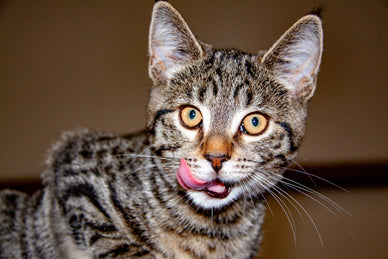
7 tips for raising your cat
A new pet brings a lot of life to the house and that is very nice! But to make it even nicer, it is best to give your pet a good education. Without that good education, it is possible that your pet will show unwanted behavior. In this blog you will read 7 important tips about the education of your cat and how to unlearn negative behavior.
1. Reward good behavior
Just like with people, you can stimulate good behavior by rewarding it. For example, will your cat or kitten do its business in its litter box instead of in the kitchen on the floor? Then you can reward it. Does your cat scratch the scratching post instead of the furniture? Then reward it! Does your cat play with its own toys instead of your stuff? Reward! Cats are wise enough to know that bad behavior is not rewarded and good behavior is, so they learn the difference between good and bad. This is one of the easiest ways to get your cat to stop bad behavior.
2. Provide enough scratching posts
Scratching is in their nature. Cats scratch to keep their nails sharp, to mark their territory and to blow off steam. And rather that they do the scratching on a scratching post and not your furniture, right? So provide a scratching post for your cats in the rooms where they spend most of their time. That way your cat is happy and your furniture remains undamaged.
3. Provide enough litter boxes
In order to housebreak your cat, you must provide enough litter boxes. This way your cat has plenty of opportunity to leave its needs in the right place. There is also a good rule of thumb for litter boxes: Provide as many litter boxes in the house as there are cats, plus one extra box!
Tip: Don't place them too close together either, but rather spread them out throughout your home.
4. Provide enough places to sleep
Cats love naps but they also love having peace and quiet around them. So make sure there are enough sleeping places, not only to sleep in but also as a 'refuge base' if it gets a bit too busy in the house. This way you will keep your cat's stress level under control.
5. Preparation is key!
Cats do not like things or situations that they are not used to such as combing, a lot of fuss in the house by visitors, the vet, nails being clipped, checking their teeth, you name it! By practicing these things often with the necessary rewards, you ensure that your cat gets used to them. This way you will not have any more surprises when you have visitors or have to go to the vet.
6. Spend time with your cat
Spend enough time with your cat each day. The more time you spend with your cat and the more you involve it in the house, the less it will show negative or destructive behavior. If you really give your cat too little attention, it will very quickly draw your attention by scratching the furniture, for example. So spend enough time with your cat in advance to avoid such situations.
7. Provide your cat with the right food
Cats have different needs for nutrients through all stages of their lives. For example, kittens have a totally different nutritional need than senior cats. So it is important to think carefully about what kind of food is best for your cat. Do you have doubts about which food to give your cat? Take a look at our product finder.
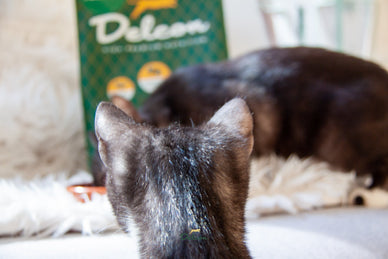
Waarom kattenvoer van Delcon?
Waarom je voor Delcon moet kiezen? Dat is een goeie vraag waar we je uitgebreid antwoord op kunnen geven! Bij Delcon Petfood streven we ernaar om een icoon van ware kwaliteit binnen de professionele wereld van premium dierenvoeding te zijn, zowel voor je hond als voor je kat. Onze voeding is met veel zorg geformuleerd. Ze is enkel opgebouwd uit de meest verfijnde ingrediënten. Zo bekomen wij de meest gezonde voeding waarop jij trots mag zijn dat je ze aan je geliefde viervoeter kan geven.
We houden zelf enorm van onze viervoeters en willen daarom enkel het beste voor hen. Daarom is onze voeding rijk aan vlees omdat dierlijke eiwitten zo belangrijk zijn voor je huisdier. De prebiotica in Delcon zorgen voor de ondersteuning van een goede darmflora en bijgevolg een optimale vertering. Daarnaast staat Delcon erom gekend een heel hoge acceptatie te hebben met een goede vertering en beperkte ontlasting als gevolg. Natuurlijke antioxidanten zorgen ervoor dat de kwaliteit van de ingrediënten in Delcon behouden blijft. Delcon bevat enkel de hoogst kwalitatieve ingrediënten waaronder ook ‘human grade’ zalmolie die de algemene gezondheidstoestand van je hond en kat ondersteunt.
Waar kan in de samenstelling van de voeding terugvinden?
Je kan de samenstelling van elke soort hondenvoer of kattenvoer terugvinden op onze website en webshop alsook op de achterkant van je zak voeding. Indien je extra vragen hebt over de samenstelling van de voeding, stuur dan gerust een mailtje naar info@delcon.be
Hebben jullie voeding die geschikt is voor kittens?
Jazeker! Delcon kitten is geschikt voor alle soorten kittens. Me kies je voor complete voeding die van bij de start een stabiele groei van uw kat ondersteunt. Hoog in eiwitten en vetten bevat Delcon Puppy alle voedingsstoffen die uw nieuwe huisgenoot nodig heeft om de eerste levensmaanden op een gezonde en gebalanceerde manier de groeispurt door te komen en het immuniteitssysteem op te bouwen.
Wanneer moet je overschakelen van Delcon Kitten naar een volwassen Delcon variëteit?
Een kitten mag je na een jaar overschakelen op een volwassen variëteit. Weet je niet goed welke variëteit het beste bij je kat past? Maak dan gebruik van onze productfinder. Door enkele vragen in te vullen, geven wij je advies welke voeding er hebt beste bij je kat past.
Waar kan je de voedingstabellen terugvinden?
Die kan je terugvinden op de website/shop of op de achterkant van je zak voeding.
Hoeveel en hoe vaak eet een kitten?
Voor kittens:
In de linkse kolom staat de leeftijd van je kat in maand uitgedrukt met daarnaast het gemiddelde gewicht van je kitten op die leeftijd zou hebben. In de rechtse kolom zie je hoeveel je kitten per dag mag eten. Tot ze 12 maand zijn verdeel je die dagelijkse hoeveelheid best over 3 maaltijden per dag.
Even schetsen adhv een voorbeeld: Je hebt een Brits korthaar kitten van 5 maand oud en die weegt ongeveer 3kg. Dan mag je ongeveer 130 gr verdelen over 3 maaltijden per dag.
Hoeveel en hoe vaak eet een kat?
Voor volwassen kat:
Heel simpel, in deze tabel zie je links het gewicht en rechts de hoeveelheid die je kat per dag mag krijgen. Deze hoeveelheid mag je verdelen over 2 maaltijden per dag.
Even schetsen adhv een voorbeeld: Je hebt een Maine Coon die 7 kg weegt. Dan zie je dat je kat 113gr per dag mag geven die je verdeelt over twee maaltijden.
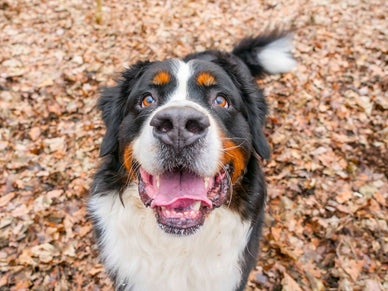
Waarom hondenvoer van Delcon?
Waarom je voor Delcon moet kiezen? Dat is een goeie vraag waar we je uitgebreid antwoord op kunnen geven! Bij Delcon Petfood streven we ernaar om een icoon van ware kwaliteit binnen de professionele wereld van premium dierenvoeding te zijn, zowel voor je hond als voor je kat. Onze voeding is met veel zorg geformuleerd. Ze is enkel opgebouwd uit de meest verfijnde ingrediënten. Zo bekomen wij de meest gezonde voeding waarop jij trots mag zijn dat je ze aan je geliefde viervoeter kan geven.
We houden zelf enorm van onze viervoeters en willen daarom enkel het beste voor hen. Daarom is onze voeding rijk aan vlees omdat dierlijke eiwitten zo belangrijk zijn voor je huisdier. De prebiotica in Delcon zorgen voor de ondersteuning van een goede darmflora en bijgevolg een optimale vertering. Daarnaast staat Delcon erom gekend een heel hoge acceptatie te hebben met een goede vertering en beperkte ontlasting als gevolg. Natuurlijke antioxidanten zorgen ervoor dat de kwaliteit van de ingrediënten in Delcon behouden blijft. Delcon bevat enkel de hoogst kwalitatieve ingrediënten waaronder ook ‘human grade’ zalmolie die de algemene gezondheidstoestand van je hond en kat ondersteunt.
Waar kan in de samenstelling van de voeding terugvinden?
Je kan de samenstelling van elke soort hondenvoer of kattenvoer terugvinden op onze website en webshop alsook op de achterkant van je zak voeding. Indien je extra vragen hebt over de samenstelling van de voeding, stuur dan gerust een mailtje naar info@delcon.be
Hebben jullie voeding die geschikt is voor puppies en jonge honden?
Jazeker! Delcon puppy is geschikt voor alle soorten pups. Met Delcon Puppy kies je voor complete voeding die van bij de start een stabiele groei van uw hond ondersteunt. Door het hoge percentage in eiwitten en vetten bevat Delcon Puppy alle voedingsstoffen die uw nieuwe huisgenoot nodig heeft om de eerste levensmaanden op een gezonde en gebalanceerde manier de groeispurt door te komen en het immuniteitssysteem op te bouwen.
Ook de jonge hondjes tussen +/- 6 maand en 1,5 jaar vergeten we niet! Delcon Junior is de perfecte voeding voor de overgang van de puppy-voeding naar een adult-variëteit. In deze levensfase is het van groot belang de spiermassa op een juiste manier op te bouwen, alsook ervoor te zorgen dat het gestel en gewrichten op een evenwichtige manier de finale vorm verkrijgen. Deze brok bevat alle nodige voedingsstoffen om de groei op een stabiele manier te ondersteunen.
Wanneer moet je overschakelen van Delcon Puppy naar Delcon Junior
Hoelang mag je pup puppy voeding eten?
Voor kleine rassen: 1-12 maand
Voor middelgrote rassen: 1-8 maand
Voor grote rassen: 1-6 maand
Opgelet! De kleine rassen mogen na 12 maand onmiddellijk overschakelen op volwassen voeding.
Is je hond (van middelgroot of groot ras) rond 6 à 8 maand, afhankelijk van de grootte van het ras, dan wordt het tijd om over te schakelen naar Delcon Junior.
Waar kan je de voedingstabellen terugvinden?
Die kan je terugvinden op de website/shop of op de achterkant van je zak voeding.
Hoeveel en hoe vaak eet een puppy?
Voor puppies:
In de linkerkolom vind je het gewicht terug die je pup heeft als hij volwassen is. Bovenaan kijk je hoe oud je pup is op dit moment, in de rij eronder zie je hoeveel maaltijden je pup mag eten per dag. Tot hun 6 maand, verdeel je de hoeveelheid over 3 maaltijden. Later mag je overschakelen naar 2 maaltijden. Bij recommended quantity zie je hoeveel gram je pup per DAG mag eten. Deze hoeveelheid verdeel je dan over het aantal maaltijden je pup mag eten.
Even schetsen adhv een voorbeeld: Je hebt een boxer pup van 5 maand oud. Een boxer weegt als volwassen hond ongeveer 25kg, dus links kijk je naar de 25kg. Nu is de pup 5 maand oud, dus kijk je bovenaan tussen 4-6maand. Daar zie je dat je pup 3x per dag mag eten. Dus je pup mag 380gr per dag eten en dit verdeel je over drie maaltijden.
Hoeveel en hoe vaak eet een hond?
Voor volwassen honden:
In de linkerkolom zie je het gewicht van je hond. Bovenaan zie je de activiteitsgraad van je hond. Kijk bij het gewicht van je hond en zijn activiteitsgraad, hoeveel gram je hond per dag mag eten. Dit gewicht mag je dan verdelen over 2 maaltijden.
Even schetsen adhv een voorbeeld: Je hebt een Boxer van 2 jaar oud, weegt 22kg en is enorm actief. Dan zie je dat je hond 330gr per dag mag eten die je mag verdelen over twee maaltijden.
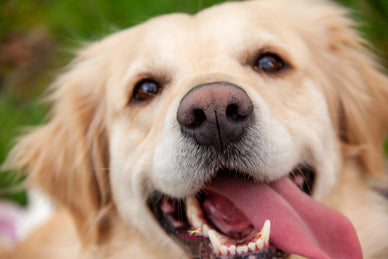
Denkspelletjes voor je hond, de optimale tijdsbesteding
Dat een hond veel beter kan ruiken dan een mens, wist je waarschijnlijk al. Dat een hond zijn neus achternagaat is dus maar meer dan normaal. Je hond vindt het fijn om met zijn neus aan het werk gezet te worden! Breinwerk voor je hond dmv denkspelletjes en snuffelspelletjes stimuleren je hond z’n hersenen, geeft ze een voldaan gevoel én schept er bovenop nog eens een betere band met z’n baasje. Zeker de moeite waard om eens uit te proberen, nietwaar?
Hoe begin je hieraan?
Je hoeft niet per se spelletjes kopen in de winkel. Je kan gerust met de huishoudspullen die je thuis hebt liggen, een fantastisch spel creëren voor je hond! Lege flessen, kartonnen dozen, oude stukken stof, siliconen bakvorm, … je noemt het maar op en je kan er wel iets van maken waar je je hond kan mee entertainen. Zo goed als alles is geschikt om een lekker hondensnoepje in of onder te verbergen (zolang het materiaal natuurlijk veilig is voor je hond).
Voorbeeld: Laat je creativiteit om los en maak zelf een snuffelmat van oude lapjes stof die je hebt liggen. Verstop er een aantal hondensnoepjes in en laat je hond er maar op los snuffelen. Of vul een kartonnen doos met lege wc-rolletjes en verspreidt er z’n lekkere hondenbrokjes in.
Het doel van hondenspelletjes
Hersenwerk voor je hond biedt tal van voordelen. Het helpt het concentratievermogen van je hond, haalt zijn energiepeil naar omlaag, maar het voordeel dat er torenhoog bovenuit springt, is toch wel het feit dat het je hond zijn brein stimuleert. In plaats van hun spieren in het werk te zetten (in bv. een trektouw spelletje), zet je nu hun neus in het werk om bepaalde zaken op te speuren. Wat fantastisch is voor je hondje, het geeft hun een voldaan gevoel. Schakel regelmatig hersenspelletjes in de wekelijkse routine van je hond, het zal je hond zijn denkvermogen scherp houden.
Connectie
Naast het feit dat het een stimulans is voor het brein van je hond, helpt het ook je hond zijn energie kwijt te spelen. Maar begrijp ons niet verkeerd, het is natuurlijk een ander soort vermoeidheid dan na een grote wandeling. Honden hebben zowel fysieke als mentale uitdagingen nodig! Binnen de fysieke en mentale uitdaging staat de connectie met het baasje ook centraal. Door samen te werken en te spelen, ga je je hond van dichterbij leren kennen en zien hoe hij omgaat met het oplossen van ‘problemen’ of puzzels. Op die manier kan je snel verder werken op zaken die je hond fijn vindt om te doen.
Puzzelen voor iedereen
Hersenwerk is voor elk soort hond weggelegd, als het goed wordt getoond aan de hond. Het spel moet aangepast zijn aan de behoeften van je hond. Voederen vanuit een KONG waarbij de hond moet likken en kauwen werkt rustgevend. Terwijl voeding in een voederbal geven eerder voor meer energie zorgt. Heb je een hond die wat meer beweging kan gebruiken? Dan is een voederbal eerder de juist keuze voor jullie. Moet je hond zich voor eender welke reden (zoals een operatie gehad) zich eerder rustig houden? Dan zijn denkspelletjes ook de ideale oplossing om hen actief en bezig te houden.
Tijd om een hersenspelletje in huis te halen!
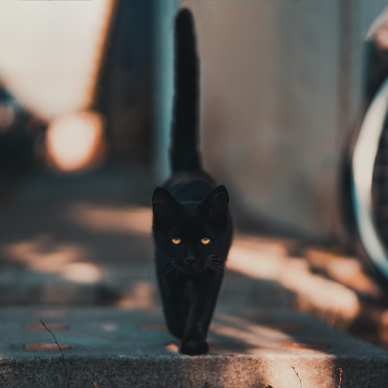
Bijgeloof rond zwarte katten
Vanwaar komt de superstitie rond zwarte katten?
Halloween staat om de hoek. Tijd om de griezelverhalen weer van onder het stof te halen en daarbij vind je altijd een terugkerend fenomeen: de gevreesde zwarte kat die steeds gepaard gaat met ongeluk. Maar van waar komt dat bijgeloof nu eigenlijk? Hier vind je alles over het verband tussen de zwarte katten en ongeluk.
Ongeluk en zwarte katten
We hebben er ons allemaal wel al eens schuldig aangemaakt. Je ziet er zwarte kat op straat en vrij wel onmiddellijk leg je de link dat er wel eens gevaar op de loer kan liggen. Je bent hier niet alleen in! De fabel dat zwarte katten ongeluk brengen, gaat al mee sinds de middeleeuwen. Toentertijd geloofden de mensen heel hard in het bestaan van heksen en duivel en ook zij kregen een huisdier erbij geplakt, namelijk de zwarte kat. Door de enorme schrik die ze toen hadden van ‘hekserij’ hadden de zwarte katten die ermee geassocieerd werd een heel zwarte tijd toen. Ze werden vaak gemeden of zelfs mishandeld. Gelukkig liggen die dagen héél ver achter hen!
Maar waarom geloofden mensen dat katten ongeluk met zich meebrengen?
Bijgeloof per cultuur
Bijgeloof in katten verschilt per cultuur. In Amerika bv. zijn er wel duizenden katten ter dood veroordeeld omwille van hun vacht. Toen werden ze geassocieerd met hekserij en de duivel. Terwijl in Engeland de zwarte vacht dan weer wel een positieve connotatie had. Daar geloofden ze juist dat de katten geluk brachten. Dit bijgeloof ontstond door dat zeelui steeds een zwarte kat mee aan boord namen. Hun taak was het vangen van de muizen maar de zeelui geloofden ook dat ze voor mooi weer zorgden tijdens hun vaart. Tot op de dag van vandaag worden zwarte katten in Engeland nog steeds geassocieerd met geluk.
Hekserij en de duivel
Tijdens de middeleeuwen waren heksen en de duivel amper weg te denken, mensen toen waren er rotsvast van overtuigd dat ze bestonden. En ze hadden wel meer verzinsels rondom de heksen en de duivel gemaakt. Zoals ze bv. dachten dat heksen s nachts in zwarte katten veranderden, vervolgens naar bossen liepen waar ze samen dansten in de heksencirkels om rituelen uit te voeren en mensen te vervloeken. Daarnaast geloofden ze ook dat zwarte katten de reïncarnatie waren van de duivel. Net zoals de heksen bracht de duivel onrust en ongeluk aan mensen die hij tegenkwam.
Deze ‘theorieën’ ontstonden in Amerika en baanden doorheen de jaren langzaamaan hun weg doorheen Europa. Dus het is helemaal niet gek dat ook jij de zwarte kat ook aan ongeluk linkt.
Tijd om de zwarte katten in de bloemetjes te zetten
Uiteindelijk blijven al deze verhalen maar oude fabels. Een kat met een zwarte vacht is net hetzelfde als een andere kat. Maar wist je dat katten met een zwarte vacht vaker in een asiel blijven zitten dan katten met een andere vacht? Dit omdat het bijgeloof toch nog ergens blijft rondzweven in onze hoofden, wat uiterst jammer is! Hoogst tijd om de lieve zwarte katten eens in de bloemetjes te zetten met een heerlijke maaltijd!
Of ben je aan het uitkijken om een katje uit het asiel te redden? Kijk dan zeker ook even naar de katjes met een zwarte vacht en geef hen een liefdevolle thuis want die verdienen ze!
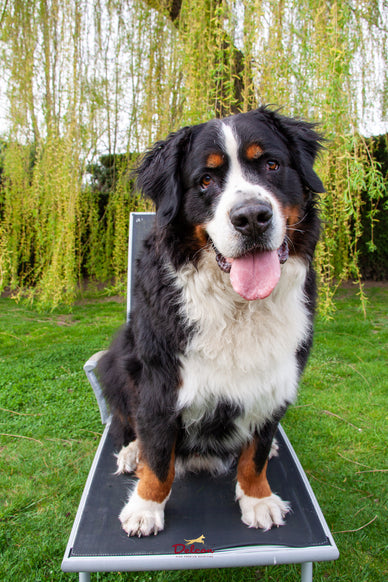
Help, het is rui seizoen!
Net je hele huis gestofzuigd en je ziet na 5 minuten alweer overal plukje haar liggen? Je bent niet alleen! Als temperaturen aanzienlijk stijgen of dalen, wordt het verharen van je dier een pak erger. Met de Herfst die net gearriveerd is, is de ‘ruiperiode’ opnieuw volop aangebroken. Maar hoe werkt een rui nu helemaal? En wat kan je eraan doen om het je dier zo comfortabel mogelijk te maken?
Waarom verharen ze?
Nu het weer wat kouder wordt, is het tijd om hun zomerplunje terug de kast in te hangen en hun winterjas weer aan te trekken, bij wijze van spreken natuurlijk! Voor katten geldt net hetzelfde. Met als gevolg: overal in huis haren… Maar hoe komt dit?
De vacht van je dier helpt hen bij het reguleren van temperaturen. Ze zorgen ervoor dat het hen warm of koel houdt. Tweemaal per jaar, bij de seizoen wissels, verliezen zowel kat als hond een pak haar. Zo’n periode van rui kan 3 à 4 weken duren en zorgt daarbij ook voor de nodige irritatie bij het dier én het baasje. Om deze irritatie op een laag pitje te houden, is het belangrijk te weten wat te doen.
Elke vacht is anders
Ken de vacht van je dier, want bij elk ras verschilt de vacht. Daarom heeft elk ras een andere verzorging nodig. Sommige hondenrassen verharen het hele jaar door maar in heel lichte mate en niet tweemaal per jaar in een piek zoals de Labradoodle, deze soort honden hebben een knipvacht. Het is noodzakelijk van hen vaak te borstelen om de losse haren uit hun vacht te halen. Terwijl je ook honden hebt met een plukvacht, ook zij verharen het hele jaar door maar die losse haren blijven hangen in de vacht. 2 maal per jaar worden die dode haren eruit ‘geplukt’ zodat de nieuwe ondervacht ademruimte krijgt. Het is van groot belang dat je nagaat welke vachtverzorging jouw hond nodig heeft. Stel dat je een hond met plukvacht gaat bijknippen, wordt hun vacht grauw en gaan de dode haren jeuken. Of borstel je de vacht van een kniphond te weinig? Dan klit de vacht samen en hoopt het vuil zich op.
Wist je dat: honden met een knipvacht minder verharen, mààr ze moeten wij op tijd en stond geknipt worden.
Hoe onderhoud je best de vacht tijdens de ruiperiode?
Jaren terug in tijd verzorgden honden hun eigen vacht, zonder enig probleem. Het verharen verloopt natuurlijk onder invloed van temperatuur en honden verwijderen zelf voor dat de losse haren dmv likken, in plassen te ronden of zich over het gras te schuren. Maar doordat honden tegenwoordig vaker binnen leven, kan hun balans verstoord worden. Daarom is het van belang dat we onze honden een handje helpen door regelmatig de losse haren weg te borstelen. Zeker tijdens de rui periode, help je je dieren hier enorm mee.
Let op: bij kortharige honden kan te veel borstelen de huid beschadigen. Hou hier rekening mee.
Keuze hondenborstel
Zorg ervoor dat je zeker de juiste hondenborstel koopt. Voor kortharige honden is een rubberen borstel of een borstel van haar meer dan voldoende terwijl voor langharige honden eerder een kam of slickerborstel nodig is om hun klittende vacht los te krijgen.
Voorbeeld van een slickerborstel:
Hoe borstelen
Druk zeker niet te hard tijdens het borstelen om irritatie over de huid te voorkomen. Om ook klitten te voorkomen, is het goed om volgende plekken wat extra aandacht te schenken tijdens het borstelen:
Bij de snuit
In de oksels
Rond de oren
Rond de voetzolen
Onder de staart
Helpt wassen?
Het antwoord: Ja maar voornamelijk voor langharige honden! Soms kan je hond wassen ook voor een verademing zorgen bij hen. Door het stromende water en shampoo week je automatisch de dode haren los. Blaas nadien je hond met koele licht droog om zo extra klitten te voorkomen. Doe dit 1 à 2 keer in de rui periode.
Voor kortharige honden is dit minder van belang. Te veel wassen kan de huid onder de vacht beschadigen.
Extra hulp nodig?
Heeft je hond vaker last van extreem vacht verlies of staat de vacht dof en levenloos? Dan kan je, naast een goede verzorging, ook de voeding aanpassen van je hond. Delcon Regular Plus – Rich in Fish is de perfecte voeding voor honden die extra zorg nodig hebben voor hun vacht dankzij de toevoeding van extra zalmolie. Kom hier alles te weten over deze voeding
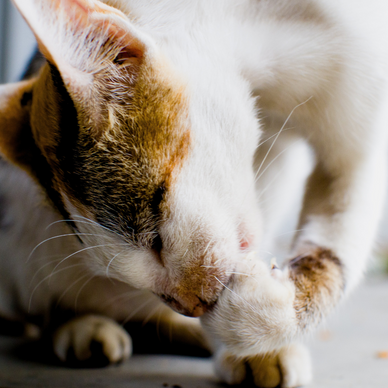
Waarom wast een kat zich zo vaak?
Wist je dat katten bijna de helft van hun wakkere tijd spenderen aan wassen? Dit omvat bijna 15% van hun dag. Da’s best veel dus waarom doen ze dit eigenlijk? Dat leggen we je graag uit.
Dankzij de ruwe haakjes op de tong verzorgt de kat zijn eigen vacht. Maar het wassen is niet enkel om zich schoon te maken, het zorgt er ook voor dat de vacht waterbestendig wordt. Dit doordat ze talg vanuit de huid over de vacht verdelen. De manier waarop ze zich wassen geeft interessante informatie mee over hun gezondheid.
Let op: Het wassen van hun vacht brengt ook met zich mee dat ze heel wat haren inslikken en dus af en toe weer een haarbal kunnen uitbraken.
Isolerende vacht
De vacht van een kat kan ook wel eens in de knoop geraken. Katten wassen zich om die knopen eruit te halen. Vacht zonder enige knoop heeft een betere isolatie, zo’n knopen verstoren de isolerende functie van de vacht waardoor ze lichaamswarmte kwijt geraken. In de zomer helpt hun vacht dan weer eerder om verkoeling te brengen. In tegenstelling tot honden die hijgen om warmte kwijt te geraken, likt een kat z’n vacht om die warmte kwijt te spelen. Als het speeksel dat wordt achtergelaten op de vacht verdampt, zorgt dit voor verkoeling voor je kat.
Tip: Help je kat door ze vaak te kammen. Zeker langharige katten zullen je dankbaar zijn dat je hun overtallige haren regelmatig weg kamt.
Teken van affectie
Katten likken ook wel andere katten hun vacht schoon, dit is hun teken van affectie. Likt je kat bv. aan jouw haar of over je handen? Dan geven ze een teken van zich op hun gemak te voelen bij jou. Geef je kat zichzelf een uitgebreide wasbeurt bij jou in de buurt? Voel je dan geprezen want dat wil zeggen je kat zich veilig voelt bij jou.
Wist je dat katten af en toe overspronggedrag kunnen tonen? Heb je je kat al ooit eens betrapt op iets wat ze niet mag doen? En ze begint zich spontaan te wassen tijdens deze situatie? Dan gebruiken ze dit als afleidingsmanoeuvre voor jou.
Eigen geur
Heb je je kat net geknuffeld, en je kat start onmiddellijk met zich te wassen? Dan is dit waarschijnlijk omdat je parfum op hem is blijven hangen. Katten hebben hun eigen geur en houden er ook van. Liefst van al willen ze zo snel mogelijk hun eigen geur terug en dit doen ze door zich volledig te wassen.
Tip: vermijd straffe parfums als je van plan bent je kat te knuffelen.
Opgelet met overmatig wassen van de vacht!
Katten ontwikkelen een routine in het wassen van hun vacht. Ze wassen zich vaak op bepaalde tijdstippen zoals na het eten, na het slapen, … En in een bepaalde volgorde zoals na het eten hun kop, na het slapen hun buik, etc.
Merk je plots verandering op in dit gedrag (bv. 1 plek extra veel wassen), dan kan dit gezondheidsproblemen aantonen. Wast je kat zich overmatig aan zijn bek? Dan kan dit wijzen op tand problemen. Wast en krabt hij zich overmatig op bepaalde plekken? Dan heeft je kat wellicht last van huid- of vachtproblemen (teken, vlooien, ..). Wast je kat zijn genitaliën vaker? Dan kan dit een teken zijn van urinewegen of blaasproblemen. Merk je zo een symptoom op? Ga dan langs bij je dierenarts.
Naast gezondheidsproblemen kan overmatig wassen ook duiden op verveling of stress. Voelt je kat zich ongemakkelijk? Dan gaat hij zich constant wassen, soms zelf tot kale plekken als gevolg toe. Zorg er dus voor dat je kat zich goed in zijn vel voelt.
Heb je het tegenovergestelde probleem en wast je kat zich amper? Dan kan er ook iets meer aan de hand zijn. Hoewel het bij senior katten voorkomt dat ze zich minder wassen, komt dit bij hen door het feit dat ze minder mobiel zijn, niets om je zorgen over te maken. Maar een zieke kat stopt ook met zich te wassen. Valt het je op dat hij veranderd is in z’n gedrag, dan is het tijd om de dierenarts te belletje te geven. Hou je kat z’n wasroutine maar best in de gaten, zo merk je snel veranderingen op.
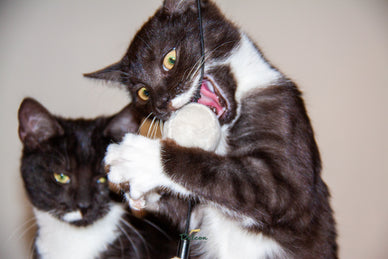
Je kat krabt al je meubels de vernieling in… Wat nu?
De kat krabt de krollen van de trap … en al de rest! Katten krabben aan heel wat zaken op hun pad. Je hoort het wel vaker dat katten eerder voor je meubels kiezen terwijl ze hun krabpaal volledig links laten liggen… Krabben is voor katten heel natuurlijk en is niet iets dat je zomaar kan afleren.
Waarom krabt een kat (aan mijn meubels)?
Een kat gebruikt zijn klauwen voor verschillende redenen:
Het is hun manier van communiceren. Naast de zichtbare schade die ze hebben aangericht, laten ze ook een onzichtbaar spoor achter. Dit is om aan andere katten te laten weten dat dit hun territorium is.
Ze onderhouden hun nagels hierdoor. Door te krabben verwijderen ze de buitenste laag van de nagel waardoor die scherp blijven.
Ze krabben om je aandacht te trekken. Kittens leren ook al heel snel dat ze je aandacht trekken door naar je handen of voeten te krabben. Hoe schattig het op dan moment ook lijkt, het is dan eigenlijk het ideale moment om je kitten naar de krabpaal te leiden.
Is er een plotselinge verandering in het huis zoals een pasgeboren baby of volledig nieuw interieur? Dan kan het ertoe leiden dat je kat opnieuw gaat krabben om zijn territorium opnieuw af te bakenen.
Ze kunnen hiermee ook aantonen dat ze zich vervelen. Zeker als het een binnenhuiskat is, moeten ze voldoende mentaal worden uitgedaagd.
Katten die buiten lopen, tonen ook krabgedrag. Maar dit aan hekken of bomen. Meubels met een verticaal oppervlak hebben in hun ogen dezelfde functie. Katten hebben niet de intentie om je meubels dus kapot te krabben. Straf daarom je kat niet maar toon hen de weg naar hun krabpaal.
Welke krabpaal moet ik aanschaffen?
Hoe graag je je kat ook ziet, je hebt toch liever niet dat ze aan je meubels krabben. Daarom is het aanschaffen van een geschikte krabpaal belangrijk.
Maar hoe vind je dit geschikte krabpaal?
Hou je kat in de gaten en kijk in wat voor soort materiaal hij het liefst zijn nagels zet. Is dit een houten oppervlakte? Of eerder in trapbekleding? Laat hij zijn sporen achter op horizontale of verticale vlakken?
Zoek een krabpaal die gemaakt is uit een gelijkaardig materiaal én die lijkt op zijn favoriete ‘krabplekje’. Geen nood, er bestaan enorm veel soorten krabpalen.
Hou er rekening mee dat de krabpaal is afgestemd op de lengte van je kat. Ze houden ervan zich flink uit te rekken!
Naast krabben, houden ze ook van springen. Nemen dus zeker krabpalen met één of meerdere platformen mee in je selectie!
Hoe leer je ze een krabpaal te gebruiken?
Maak eerst je meubels schoon, zodat alle geursporen verdwenen zijn. Zet vervolgens de krabpaal in de buurt, zo kan je kat ermee kennismaken. Laat hem het nieuwe object ontdekken.
Leg wat kattenvoer of snoepjes op de paal om hen aan te moedigen
Speel met je kat rondom de krabpaal en laat ze er naartoe gaan.
LET OP: dwing ze nooit om aan de paal te krabben door bv. hun pootjes met je handen erop te zetten. Je maakt hen hierdoor nerveus en je verkleint ermee de kans dat hij de krabpaal zal aanvaarden.
Eenmaal ze begonnen zijn met de krabpaal, zorgen de krabsporen en feromonen ervoor dat ze steeds terugkeren én de interesse in het meubilair is vervagen.
Ben je geslaagd in je opzet om je kat zich te laten amuseren met de krabpaal? Beloon hem dan met een heerlijk kommetje korrels!
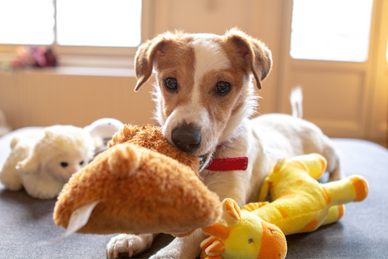
5 leuke spelletjes om binnen te spelen met je hond
Een regenachtige dag is niet leuk voor jou en al zeker niet voor je hond. Jij mist het om een frisse neus te halen, je hond is verknocht aan z’n dagelijkse fysieke uitdaging. Laat de neerslag de pret niet bederven. Dat je ook binnen fijn met je hond kan spelen, bewijzen de vijf spelletjes die je in dit artikel ontdekt. Is het geen weer om je hond door te jagen? Speel dan binnen!
1. Zoek het snoepje
“Zoek het snoepje” is een fantastisch spelletje dat de hersenen en de neus van je hond aan het werk zet. Met al die verstopplaatsen in huis is het een ideale activiteit om binnen met je hond te doen.
Moeilijkheid
Benodigdheden?
Leertijd
Gemakkelijk
Snoepjes zoals de Delcon Treats en een rustige plek
1 tot 4 weken
---article-upsell-here---
De voorbereiding
Voor je “Zoek het snoepje” begint te spelen, zoek je een rustig plekje in huis. Hou enkele van de favoriete snoepjes van je hond bij de hand. Wees geduldig. De ene hond snapt het spelletje meteen, de andere heeft wat meer tijd nodig. Hoe jonger je hond, hoe makkelijker hij het zal oppikken.
Hoe snel je hond ook leert, hou het leuk voor jullie beide. Zelfs al lukt het niet meteen, weet dat je hond aan het leren is en zijn brein hard aan het werken is.
Aan de slag
Vraag je hond om te zitten en te blijven.
Toon je hond het snoepje en gooi het op de grond.
Geef je hond de toestemming om het snoepje te halen.
Dat doe je door bijvoorbeeld “Zoek!” te zeggen. Herhaal deze stap enkele keren zodat je hond snapt wat de bedoeling is.
Laat je hond terug naar jou komen.
Om het spelletje uitdagender te maken, doe je het volgende:
Gooi het snoepje steeds verder. Het is de bedoeling dat je hond blijft zitten tot je hem vraagt het snoepje te zoeken.
Verstop het snoepje achter, in of onder iets. Gebruik bijvoorbeeld een snuffelmat om je snoepje in te verstoppen.
Heeft je hond het moeilijk om te blijven zitten tot je toestemming geeft het snoepje te halen? Werk dan met een lijntje tot je hond zijn impulsen beter onder controle heeft.
2. Touwtje-trek
Door touwtje-trek te spelen, kan je hond zijn energie meteen kwijt. Speel het bijvoorbeeld als je een langere tijd van huis bent geweest en je hond al die tijd alleen was. Je overactieve hond is na enkele minuten touwtje-trek al heel wat kalmer en dankbaar voor alle aandacht!
Moeilijkheid
Benodigdheden?
Leertijd
Gemakkelijk
Snoepjes zoals de Delcon Treats, een stevig touw
2 tot 7 dagen
De voorbereiding
Kies een speeltje op maat van je hond. Het spreekt voor zich dat een uit de kluiten gewassen Tervuurse Herder een steviger touw vraagt dan een Jack Russel. Je vindt speciale touwen voor honden in een dierenspeciaalzaak of je knutselt zelf een speeltje ineen door enkele lappen stof stevig aan elkaar te knopen.
Maak je hond enthousiast zodat hij zich gemotiveerd voelt om z’n tanden in het speeltje te zetten. Met een snoepje als beloning wordt dit vast en zeker één van z’n favoriete spelletjes.
Aan de slag
Zoek een plekje in huis met voldoende plaats om touwtje-trek te spelen
Hou het touw bij de hand en enkele snoepjes in je broekzak.
Presenteer het touw aan je hond
Hou het touw voor hem. Niet elke hond zal meteen interesse tonen. Doe er zelf enthousiast over, laat het voor zijn neus bengelen of verleid hem met een snoepje.
Moedig je hond aan om te trekken
Verbind er ook een commando aan zoals “Trek!”. Hou het speels zodat je hond snapt dat het een spelletje is.
Wacht op contact
Elke aanraking met het touw of speeltje is een reden voor een beloning. Zo weet je hond dat als hij interesse toont, hij een snoepje krijgt.
Wees consequent en geduldig
Herhaal dit proces enkele keren maar verleg steeds z’n grenzen. Vraag meer interesse van je hond in ruil voor een snoepje. Doe dit tot hij snapt dat hij aan het touw hoort te trekken. Geef hem daarna pas een snoepje in ruil voor 10 seconden touwtje-trek, 20 seconden touwtje-trek, 30 seconden touwtje-trek, … Op termijn heeft hij enkel nog jouw commando “Trek!” nodig om te weten wat je van hem vraagt.
3. Welke hand?
“Welke hand?” is een heel eenvoudig spelletje dat je om het even waar en wanneer kan spelen. Het enige wat je nodig hebt is enkele snoepjes en je handen.
Moeilijkheid
Benodigdheden?
Leertijd
Gemakkelijk
Snoepjes zoals de Delcon Treats
2 tot 7 dagen
De voorbereiding
“Welke hand?” stelt de hersenen en de neus van je hond op de proef. Je vraagt hem niet enkel z’n reukvermogen te gebruiken, je stimuleert ook het denkvermogen van je hond. Dit alles in een heel eenvoudig maar oh zo leuk spelletje. Het enige wat je nodig hebt, zijn je handen en enkele van z’n favoriete snoepjes.
Gebruik in het begin bij voorkeur snoepjes die sterk ruiken, zoals onze snoepjes met zalm, eend of lam. Heeft je hond een favoriete snack? Kies die dan uit. Zo krijg je hem extra gemotiveerd.
Aan de slag
Snoepje in de hand
Vraag de aandacht van je hond en toon hem dat je een snoepje in één van je handen hebt. Sluit beide handen en presenteer ze aan je hond.
Welke hand?
Vraag je hond “Welke hand?” en wacht tot hij een voorkeur toont voor één van je handen. Open vervolgens die hand. Heeft hij het bij het rechte eind? Dan heeft hij het snoepje gewonnen! Was hij verkeerd? Toon dan het snoepje maar geef het niet. Probeer het spelletje opnieuw tot je hond het juist heeft.
Wil je het spelletje uitdagender maken? Verstop je beide handen dan achter je rug en wissel het snoepje tussen je handen. Zo weet je zeker dat je hond enkel op zijn geur rekent en niet op wat hij ziet.
4. Het bekertjes-spelletje
Het bekertjes-spelletje bouwt voort op het “Welke hand?”-spelletje. Het principe is hetzelfde met dat verschil dat je bekertjes gebruikt in plaats van je handen. Vindt jouw hond meteen onder welk potje je het snoepje hebt verborgen?
Moeilijkheid
Benodigdheden?
Leertijd
Gemakkelijk
Snoepjes zoals de Delcon Treats, 3 bekertjes
1 tot 4 weken
De voorbereiding
De enige voorbereiding die dit spelletje vraagt, is drie bekertjes. Kies voor plastic en niet voor glas of papier. Papier is niet stevig genoeg en glas kan breken. Maak een gaatje in de onderkant van elk bekertje zodat je hond het snoepje kan ruiken. Eens je hond het spelletje goed kent, gebruik je bekertjes zonder gaatje.
Aan de slag
Vraag de aandacht van je hond
Verstop een snoepje onder een bekertje
Vraag je hond om het snoepje te vinden
Om dit spelletje moeilijker te maken, voeg je simpelweg extra bekertjes toe.
5. Samen opruimen
Na een speelmomentje met de hond ligt je huis er gegarandeerd rommelig bij. Waarom niet het nuttige aan het aangename koppelen en je hond leren zijn eigen spullen op te ruimen?
Moeilijkheid
Benodigdheden?
Leertijd
Moeilijk
Snoepjes zoals de Delcon Treats, enkele speeltjes en een mand om de speeltjes in op te bergen
2 tot 6 weken
De voorbereiding
Neem er de doos, mand of ton bij waarin je de speeltjes van je hond verzamelt. Slingeren er nog geen speeltjes rond, leg er dan enkele op de grond. Hou ook enkele snoepjes bij de hand om je hond te belonen.
Je hond leren opruimen is niet makkelijk. Zorg ervoor dat je hond al de basis kent zoals “zit” en “blijf”. Lukt het niet na één sessie? Wees geduldig en consequent. Je hond heeft tijd nodig om nieuwe dingen te leren. Geloof ons: hij is het wachten waard!
Leren opruimen stimuleert de hersenen van je hond en laat hem z’n overtollige energie kwijtraken. Eens de speeltijd over is en alles is opgeruimd, is je hond voldaan en klaar voor z’n welverdiende dutje.
Aan de slag
Leer je hond om een speeltje te nemen.
Hiervoor hou je z’n favoriete speeltje voor z’n snoet. Net voor hij het speeltje wil nemen, zeg je “Pak!”.
Leer je hond om het speeltje los te laten.
Nu je hond z’n speeltje vast heeft, verleid je hem met z’n favoriete snoepje met zalm, eend of lam. Van zodra hij voor het snoepje kiest en het speeltje laat vallen, zeg je “Los!”.
Leer je hond z’n speeltje in de mand leggen.
Leg daarvoor enkele speeltjes rond de mand, wijs naar een speeltje en zeg “Pak!”. Van zodra je hond het speeltje vast heeft, begeleid je hem met een snoepje richting de mand. Eens zijn hoofd boven de mand is, zeg je “Los!”. Valt het speeltje in de mand, beloon je je hond met het snoepje.
Leg de speeltjes verder van de mand.
Blijf verder oefenen met de snoepjes maar verminder het aantal keren dat je je hond beloont. Introduceer het oppakken en in de mand laten vallen van de speeltjes geleidelijk aan als “Opruimen!”.
Herhalen, herhalen, herhalen.
Herhaal het opruimen elke dag gedurende minimum twee weken. Merk je dat je hond een stap niet zo goed onder de knie heeft, oefen dan specifiek op dat commando.
Waarom binnenspelen met je hond?
Nu je weet hoe je je hond ook binnenshuis entertaint, laten we even in het brein van je hond duiken en ontdekken waarom spelen zo belangrijk is.
Waarom spelen honden?
Als je hond al in je leven is sinds hij puppy is, zat je op de eerste rij toen hij op het toppunt van z’n speelsheid zat. Puppy’s leren over de wereld rondom hen door te spelen. Ze onderzoeken hun omgeving met hun neus, tong en tanden. Zo leren ze wat aanvaardbaar sociaal gedrag is en wat hun grenzen zijn.
Ook volwassen honden blijven spelen, zowel met hun baasje als met andere honden. Meer nog: honden spelen het liefst in gezelschap. Dat ze speels blijven wil niet zeggen dat ze nooit volwassen worden. Spelen vervult enkele belangrijke functies. Hieronder vind je er vijf.
1. Spelen is gezond
Spelen heeft niet enkel fysieke voordelen, je stimuleert er ook de hersenen van je hond mee. Via een spel raakt je hond z’n opgebouwde energie kwijt. Zelfs een korte sessie van 5 à 10 minuten maakt een wereld van verschil. Ook jij ervaart vast en zeker de voordelen van wat extra beweging in je dagelijkse routine.
Het is ook een ideale manier voor je hond om stress van zich af te schudden. Hij geniet met volle teugen als hij tijd met jou spendeert. Studies verwijzen ook naar de kalmerende effecten van honden op mensen. Mensen met een hond zouden een lagere bloeddruk hebben en minder kans maken op hartziekten. Wat er ook van aan is, een speelkwartiertje met je hond inlassen, heeft voordelen voor je hond en voor jezelf.
2. Een hond kan zich vervelen
Net zoals wij vervelen honden zich soms. Dat gebeurt als ze te weinig uitdaging krijgen. Door te spelen, te wandelen en mentale stimulans, blijven ze geëntertaind en gaan ze kattenkwaad uit de weg.
Een hond die zich verveelt, herken je aan gedrag zoals blaffen zonder reden, je spullen kapot bijten, je storen terwijl je werkt, je bloemperk omwoelen, … Door af en toe een spelletje te introduceren, vermijd je dit. Dat hoeven niet per se fysieke spelletjes te zijn, ook denkspelletjes doen de verveling van je hond verdwijnen.
3. Spelen = leren
Als je hond speelt, staan al z’n zintuigen op actief. Het is daarom ook een van de leukste manieren om je hond te trainen. Geloof het of niet: een spelletje spelen, is je hond iets aanleren. Terwijl je met hem speelt, geef je hem namelijk een taak. Vervult hij die taak, wordt hij beloond. De leukste manier voor een hond om te leren en te blijven leren.
4. Een nog hechtere band
Net zoals speeltijd puppy’s alles over relaties en sociale vaardigheden leert, toon je met spelen aan je hond dat je er voor hem bent. Hij krijgt jouw onverdeelde aandacht en leert je vertrouwen. Hij komt bijvoorbeeld te weten dat als hij het balletje dat jij net hebt weggegooid terugbrengt, jij dat balletje opnieuw zal weggooien. Hij leert dat sommige van jouw acties voorspelbaar zijn. Dat geeft je hond vertrouwen.
5. Je hond wordt meer zelfzeker
Een spelletje doet beroep op het deel van de hersenen van je hond dat instaat voor het nemen van beslissingen en het controleren van impulsen. Honden die vaak spelen, blaken van zelfvertrouwen. Ze kunnen erop vertrouwen dat ze de juiste keuze zullen maken. Zowel in interactie met jou als met soortgenoten.
Veelgestelde vragen over binnen spelen met je hond
Hoe vaak moet ik met mijn hond spelen?
Het is belangrijk om elke dag met je hond te spelen. Dat is belangrijk voor hun mentaal en fysiek welzijn.
Hoe lang moet ik spelen met mijn hond?
In een ideale wereld krijgt een hond elke dag een half uur tot twee uur speeltijd. Dat lijkt enorm veel, zeker als je een fulltime job hebt. Denk daarom na welke momenten je kan omtoveren tot een spel. Bijvoorbeeld etenstijd. Waarom je de brokken van je hond in een kom gieten als je er ook spelletjes zoals “Welke hand?” of “het bekertjes-spelletje” mee kan spelen. Ook je dagelijkse wandeling leuk je eenvoudig op met een van de bovenstaande spelletje.
Moet ik mijn hond de hele dag entertainen?
Honden krijgen graag aandacht. Spendeer dan ook zoveel mogelijk tijd met je hond. Een spelletje introduceren is een perfecte manier om zijn energieniveau te doen dalen en hem mentaal uit te dagen. Zo slaagt hij er beter in om zijn spreekwoordelijke emmertje te legen.
De meeste volwassen honden slapen minstens 12 uur per dag. Hem aanleren om rust te vinden is minstens even belangrijk als voldoende entertainment.
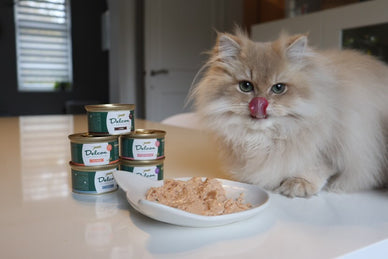
Natvoer vs. droogvoer: de keuze van de kat
Het aanbod kattenvoer is overweldigend groot. Zowel in de supermarkt als online is het aantal merken en soorten geëxplodeerd. Geen wonder dat je als katteneigenaar door de bomen het bos niet meer ziet.
Kies je beter voor natvoer of droogvoer? Zijn er verschillen in voeding die je aan je kitten, volwassen of senior kat geeft? Hoe zorg je voor een gebalanceerde maaltijd die je kat gelukkig en gezond doet voelen? Hieronder ontdek je alle antwoorden.
Kattenvoer voor elke levensfase
Welk over je ook kiest, de belangrijkste eigenschap is dat de voedingswaarde afgestemd is op de leeftijd en de levensstijl van je kat. Kittens in volle groei hebben bijvoorbeeld meer eiwitten en calorieën nodig. Gesteriliseerde katten en katten die uitsluitend binnen leven hebben dan weer minder calorieën nodig. Voeding voor senior katten bevat over het algemeen minder fosfor, om de nieren van oudere katten te ontzien.
Anderzijds hebben katten hun persoonlijke behoeften. Voeding met Psyllium helpen katten die problemen hebben met haarballen. Kattenvoer met bepaalde vetzuren brengen de huid en de vacht van katten opnieuw in topvorm.
Maar de vraag blijft: kies je dan beter voor natvoer of droge brokken? Laten we enkele feiten over kattenvoeding bekijken.
De verschillen tussen natvoer en droogvoer
Het grootste verschil tussen natvoer en droogvoer is het vochtgehalte. In natvoer zit om en bij de 60% water, in droogvoer ongeveer 14%. Natvoer wordt gekookt op hoge temperatuur en is daarom lang houdbaar in blik. Langer dan droogvoer. Eens het blikje natvoer is geopend, is de houdbaarheid een stuk korter dan de droge variant.
Daarnaast zijn er veel meer verschillende texturen beschikbaar in natvoer dan in droogvoer. Denk aan mousse, gehakt, stukjes in jus of stukjes in gelei. Droogvoer bestaat vooral in brokken, de ene soort al wat knapperiger of de andere.
De meeste merken prijzen natvoer een stuk duurder dan droogvoer. Bij Delcon is dat niet het geval.
De voordelen van natte voeding
Katten eten graag muizen. Als roofdier is dat hun typische prooi. Daarin vinden katten meer dan 60% vocht. Daarom wordt vaak geopperd dat natte kattenvoeding het meest aansluit bij de natuurlijke behoeften van katten. Dit vooral om er zeker van te zijn dat katten voldoende vocht binnen krijgen.
Natvoer heeft voordelen in deze gevallen:
Als de urinewegen van je kat ondersteuning nodig hebben (bijvoorbeeld bij blaasproblemen);
Als je het gewicht van je kat onder controle wil houden; en
Als je kat last heeft van constipatie.
De voordelen van droge voeding
De meeste katten krijgen droogvoer. Daar is niks mis mee. Integendeel! Vele katten vinden het prettiger om gedurende de dag kleine hoeveelheden te eten dan op specifieke tijdstippen een grote maaltijd te krijgen. Met droogvoer is het makkelijker om je kat zelf te laten beslissen wanneer hij of zij eet.
Brokjes stop je ook makkelijker in een speeltje. Dat is eten en mentale stimulans tegelijk.
De energetische waarde van droge voeding is over het algemeen hoger dan van natte voeding voor hetzelfde gewicht. Dat heeft voordelen voor magere katten of katten die heel kieskeurig zijn. Zelfs een kleine hoeveelheid brokken geeft hen al veel calorieën.
In een notendop
Natvoer
Droogvoer
Vochtgehalte
>60%
+- 14%
Houdbaarheid
- Ongeopend
- Geopend
Erg lang in blik
Kort
Lang
Lang
Prijs
Meestal duurder maar niet bij Delcon
Meestal goedkoper
Energetische waarde
Lager
Hoger
Om een definitieve beslissing te nemen over welke voeding het beste is voor je kat, raadpleeg je best je dierenarts.
Mag je je kat enkel droge voeding geven?
Als je kat vooral droge brokken eet, is het heel belangrijk dat je erop let dat hij of zij voldoende water drinkt. Enkele tips om ervoor te zorgen dat je kat voldoende drinkt:
Plaats kommetjes water op verschillende plekken in je woning.
Zet water en voeding weg van elkaar. Zet het water ook niet in de buurt van de kattenbak.
Kies voor een kommetje uit keramiek of inox. Plastic kan water een andere smaak geven.
Hoe vaak mag mijn kat eten?
Het aantal keren dat je je kat mag voeden, hangt af van zijn of haar leeftijd, gezondheid en voorkeur.
Leeftijd
Kittens hebben meer voedsel nodig volgens hun lichaamsgewicht dan volwassen katten. Meerdere voedingsmomenten per dag ondersteunen hun snelle groei. De meeste kittens genieten van 3 maaltijden per dag tot de leeftijd van 6 maanden. Daarna hebben ze meestal voldoende met 2 voedingsmomenten per dag, tot ze hun volwassen leeftijd hebben bereikt.
Volwassen katten – daarmee bedoelen we katten ouder dan een jaar – verkiezen 1 à 2 voedingen per dag. Senior katten – katten die 7 jaar en ouder zijn – behouden deze routine. Zolang je kat gezond is en geen ziektes hebben, is er geen reden om hen vaker of minder vaak eten te geven.
Gezondheid
Net als mensen worden katten soms ziek. Langdurige ziekten zoals diabetes bestaat ook bij katten. In dat geval moet je heel secuur omspringen met voeding. Advies van je dierenarts is onontbeerlijk.
Ouderdom heeft z’n weerslag op het gebit van je kat. Kauwen op droogvoer wordt dan moelijker. In dat geval is natte voeding vaak comfortabeler voor je senior.
Voorkeur
Je merkt snel of je kat verkiest om op vaste tijdstippen eten te krijgen of liever gedurende dag kleine hoeveelheden eet. Experimenteer ook gerust met brokjes in een speeltje als je merkt dat je kat weinig interesse toont in voedsel.
Vinden katten het vervelend om elke dag hetzelfde te eten?
Hierover zijn de meningen verdeeld. Sommige kenners stellen dat katten in het wild vooral muizen eten. Elke dag hetzelfde min of meer. Zij zien er dus geen graten in dat je je kat elke dag dezelfde droge of natte voeding geeft.
Anderen vinden dat elke dag dezelfde brokken of natte voeding gaat vervelen. Zij raden aan om ongeveer 2/3 natte voeding en 1/3 droge voeding te geven. Voldoende variëteit in de maaltijden steken, dus.
Waar iedereen het over eens is, is dat je ervoor moet zorgen dat je kat voldoende voedingsstoffen binnen krijgt. Dat doe je met voeding die is afgestemd op de leeftijd en de behoeften van je kat. In het assortiment van Delcon vind je verschillende soorten droge voeding en natte voeding, afgestemd op de leeftijd en de behoeften van je kat.
Waarom kiezen voor Delcon kattenvoer?
Dat we bij Delcon steevast kiezen voor Delcon kattenvoer spreekt voor zich. Wij weten namelijk met welke ingrediënten onze producten tot stand komen. Enkel de beste kwaliteit, daar kan je van op aan! Verfijnd, rijk aan vlees en vol prebiotica.
We willen niet enkel dat je liefste viervoeten geniet van elke maaltijd. We streven er ook naar dat onze voeding de gezondheid van je kat ondersteunt. Met een goede vertering, een glanzende vacht en een sterk immuunsysteem als logisch gevolg.
Kortom: of je nu voor natvoer of droogvoer kiest, Delcon kattenvoeding is gebalanceerd, natuurlijk en heel erg lekker. Probeer het vooral zelf! Gebruik zeker de 15% korting op je eerste aankoop via de webshop die je krijgt nadat je je hebt ingeschreven op onze nieuwsbrief.
Dit is wat anderen over Delcon kattenvoeding zeggen…
“Wij zijn heel tevreden van Delcon kattenvoeding. Onze Ragdoll van 17 jaar oud begon slecht te eten, moest vaak plassen en dronk heel veel water. Door over te schakelen op Delcon droogvoer (Sensitive) en natvoer (kip en tonijn) is onze Casper precies herboren. Hij is verzot op z’n eten, is bijgekomen, drinkt en plast terug normaal, en braakt niet langer. Bedankt, Delcon!”
Sandra
Ik gebruik al meer dan 25 jaar Delcon in mijn Cattery, op aanraden van een topfokker. Mijn katten gaan aan alle andere brokjes voorbij!
Rita
Na 1 keer Delcon geproefd te hebben, willen mijn katten niets anders meer. Voordeel is dat je snel gekozen hebt, het nadeel is dat ik zeker niet mag zonder vallen. Maar het allerbelangrijkste: mijn katten zijn heel gezond en hun vacht glanst als nooit te voren!
Karin
Overtuigd?
Neem een kijkje in ons assortiment!
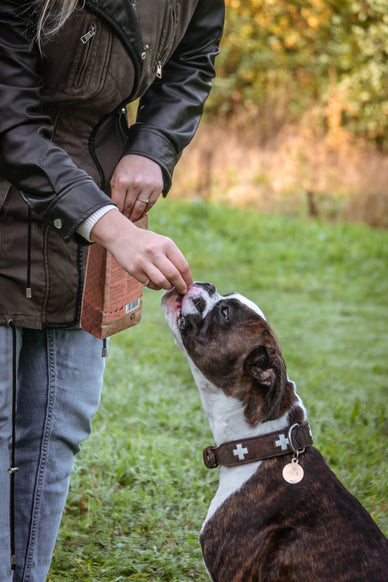
Gezonde hond, stralende vacht?
Wat de vacht van je hond jou wil vertellen…
De gezondheid van je hond lees je voor een stuk af aan de glans van zijn vacht. Omgekeerd vertelt een doffe vacht je dat er misschien iets mis is met je viervoeter. Hoe mooi de vacht van je hond glanst, hangt af van verschillende factoren. Over sommige heb je controle, over andere heel wat minder.
In deze blog lees je wat er precies invloed heeft op het uitzicht van de vacht van je hond en hoe je die gezond laat stralen.
De betekenis van een glanzende vacht
Net zoals bij mensen zorgen huidvetten voor de glans van haar. Ze leggen er een laagje op dat het licht weerkaatst. Heeft de huid van je hond voldoende van deze vetten – en op de juiste plaats – zal z’n vacht stralen.
Dat zie je aan:
De glans van de vacht,
De dikte van de pels,
De zachtheid van de haren, en
De geur van je hond.
Ziet z’n pels er op sommige momenten doffer uit, zit je hond misschien in een ruiperiode. Op dat moment heeft hij duizenden dode haren in z’n vacht zitten die van nature minder glanzen. Ook de vacht van witte honden weerkaatst het licht een stuk minder. Enkel en alleen al door de lichte kleur.
Daarnaast speelt ook het ras een rol. De vacht van ruwharige honden straalt bijvoorbeeld minder. Honden die graag in de modder rollen of zich spelend in het stof wentelen, blinken eveneens heel wat minder.
Tekenen van een ongezonde huid en vacht
Zie je naast een doffe vacht ook huidschilfers, rode of kale plekken, bultjes of zelfs korsten? Heeft de huid van je hond een kwalijke geur? Merk je dat je hond vaak krabt of zelf jankt als je bepaalde plekken aanraakt? Dan is de doffe vacht wellicht een teken van een groter probleem
De huid van de hond is net zoals bij mensen het grootste orgaan, dat daardoor enorm veel voedingsstoffen vraagt om gezond te blijven. Het lichaam van een zieke hond beschermt bovendien eerst alle vitale organen zoals het hart en de hersenen en steelt als het ware voedingsstoffen van minder belangrijke organen zoals de huid.
Ziektes of tekorten aan bepaalde voedingsstoffen weerspiegelen zich daardoor snel in het uitzicht van de huid en de vacht van je hond. Voorbeelden van aandoeningen die haaruitval veroorzaken of de huid aantasten zijn:
Allergieën,
Vlooien en andere parasieten,
Zwaarlijvigheid,
Artrose, of
Prikkelbare darmsyndroom.
Neem bij de minste twijfel contact op met je dierenarts. Die zal je zeggen of voedingstekorten de oorzaak zijn of er meer aan de hand is.
3 tips voor een gezonde huid en vacht
1. Voeding, voeding en nog eens voeding
Geen enkel supplement kan ooit een evenwichtige voeding vervangen. Een gezonde hond begint dus bij voedsel dat alle voedingsstoffen bevat die hij nodig heeft om te groeien en zich te ontwikkelen.
Bij de keuze hou je rekening met:
De leeftijd van je hond,
Zijn gewicht,
Het ras, en
Eventuele allergieën en behoeften.
Bekijk ook het gehalte aan dierlijke eiwitten in het voer. De vacht van honden bestaat grotendeels uit proteïnen en dus zijn deze best het hoofdingrediënt van het hondenvoer. Kip, lam maar ook vis zoals tonijn en zalm zijn ideale basisproteïnen voor een gezonde vacht.
Vis heeft een bijkomend voordeel voor huid en haar: omega 3. Dat zijn meervoudig onverzadigde vetzuren die cellen soepel houden. Soepele huidcellen leiden op hun beurt tot een stabiele barrière: de beschermende functie van de huid en de vacht werkt beter. In elke soort Delcon hondenvoer zit daarom zalmolie, bron van omega 3 en omega 6.
Hondenvoer van Delcon: bron van eiwitten en omega 3
Er zijn tientallen redenen waarom hondenvoer van Delcon een goede keuze is voor de gezondheid van je huisdier. Eerst en vooral zit het boordevol eiwitten aangevuld met multivitaminen en essentiële mineralen. Goed voor een volledig en gebalanceerd dieet.
We steken ook zalmolie in al onze voeding. Een natuurlijke bron van omega 3 en omega 6 die de gezondheid van de huid en vacht ondersteunt.
Daarnaast hebben we oog voor de specifieke behoeften van je hond. Honden met een doffe vacht zijn vast dol op onze hondenbrokken en snacks met vis:
Delcon Adult Regular Plus rich in Fish
Delcon Salmon Treats
Speciaal gemaakt voor actieve honden met huid- of vachtproblemen
Gezonde treats vol eiwitten en Omega 3 om een gezonde huid en vacht te ondersteunen.
2. Groom met mate
Een hond hoeft niet elke maand in bad. Een keer per seizoen is ruim voldoende. Was je je hond te vaak, leidt dit tot irritatie of droge huid. Met elke wasbeurt verwijder je namelijk de natuurlijke huidvetten die de vacht van je hond die prachtige glans geven.
Borstelen doe je dan weer zo veel mogelijk. Door te kammen verwijder je dode huidcellen en haren. Bovendien verdeel je de huidvetten zo gelijkmatig over de vacht. Sommige hondenrassen vragen 2 tot 3 kambeurten per week, andere rassen vragen veel minder borstelsessies.
3. Vermijd een beestenboel
Tussen grofweg maart en november bestaat de kans dat teken zich verschuilen in je gazon. Ook als je in het bos of velden gaat wandelen, kom je teken tegen in onze contreien. Doe je je hond geen tekenband aan, controleer je best de vacht van je hond na elke wandeling. Ook vlooien spelen je hond parten. De jeuk zorgt ervoor dat je hond zichzelf zal krabben en bijten.
Zorg er dus voor dat ongedierte geen kans krijgt om irritatie te veroorzaken. Het speeksel van vlooien kan bijvoorbeeld een allergische reactie uitlokken. Ook de beet zelf is heel onaangenaam voor je huisdier. Er bestaan verschillende middeltjes om vlooien en teken af te weren. Je dierenarts helpt je om het beste middel te vinden voor jouw hond.
Hulpmiddeltjes nodig?
Geef je je hond voeding die niet speciaal werd ontwikkeld om een gezonde huid en vacht te ondersteunen, kan je naar supplementen grijpen. Dat zijn bijvoorbeeld capsules met omega 3 of omega 6 vetzuren uit dierlijke bronnen (vis).
Trakteer je je hond elke dag op Delcon hondenvoer heb je die supplementen niet nodig. In al onze voeding zit zalmolie met voldoende omega 3 en 6. In sommige van onze snacks, zoals de Delcon Salmon Treats, zitten deze vetzuren ook.
Omega 6
Omega 6 vetzuren zijn meervoudig onverzadigde vetzuren die linolzuur bevatten. Die vind je ook terug in de vetlaag tussen de huidcellen van je hond en reguleren de waterdoorlaatbaarheid van de huid. Mist je hond omega 6, zie je dit meestal terug in een droge huid en schilfers in de vacht.
Wanneer zie je resultaat?
Sommige veranderingen vragen tijd. Pas je de voeding van je hond aan, zie je wellicht pas na anderhalve maand resultaat. Onthoud dat je bij twijfel best contact opneemt met je dierenarts.
Heb je vragen over ons assortiment hondenvoer? Neem dan contact op.
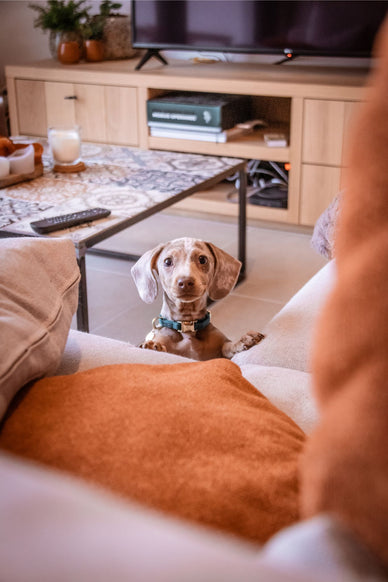
Puppy & kitten: nutrition
3 important questions about nutrition for puppies and kittens answered
When it comes to your new pet, you want only the best. Especially when it comes to nutrition. How can you be sure your puppy or kitten is getting all the nutrients he or she needs? What makes nutrition suitable for puppies and kittens?
In this blog, we answer 3 questions our customer service and veterinarians get most often around nutrition for young dogs and cats.
1. How long do puppies or kittens need appropriate nutrition?
Puppies
When your puppy moves into your home, you feed him food that is age-appropriate. You do that until your dog reaches adult age. This varies from breed to breed.
To ease the transition from puppy to adult nutrition, we have developed Delcon Junior. Small breeds like chihuahuas give puppy food until about 1 year of age. Medium-sized breeds like boxers can use puppy food until they are about 8 months. Large breeds like a Bernese are best switched at around 6 months. After that, switch to Junior food.
From the time your dog is about 15 to 18 months, switch to Adult dog food. When exactly you do that, you will have to judge for yourself. You know your dog best and one dog will be ready earlier than the other. Not sure? Then get in touch with our team.
In this blog, you can read how to specifically handle the switch from one type of food to another
Kittens
Kittens experience one growth spurt after another. Only food tailored to them will allow them to develop in a healthy and balanced way. This is why it is recommended to feed food for kittens until they are 1 year old. From the age of 12 months, your cat is basically an adult and you gradually switch to food for adult cats.
As mentioned, this transition does not happen overnight. Allow about six days for your cat to get used to the new food. This will ensure that your cat's digestive system can get used to the composition of the new food.
On day 1, replace 1/6 of the food with the new food. The majority remains the kitten food. Each day you add a sixth so that on the sixth day the portion consists only of the food for adult cats.
Is it best to feed your cat dry or wet food? Read the answer in our blog!
2. Can you give a puppy or kitten adult dog or cat food as well?
No, it is best to give puppies and kittens food that is appropriate for their age. At the beginning of their lives, they need more of certain nutrients than adult dogs or cats. Think of certain fatty acids or proteins. Or they need those nutrients in a different ratio than adults.
Only with nutrition tailored to their needs will your puppy or kitten get through the big growth spurt in a healthy and balanced way and build a strong immunity. So you can imagine that there are also big differences in fat percentage and number of calories per serving between foods for young and adult animals. Puppies and kittens need proportionally much more calories. Not too surprising when you see how fast they grow and learn!
As soon as your dog or cat reaches adult age, switch to "adult food." Do this gradually so your dog or cat can get used to the new dry or wet food. To make the transition from puppy food to adult food easier, we have launched Delcon Junior. This food pays attention to the development of young dogs' muscles and bones.
3. What ingredients contribute to the development of my puppy or kitten?
In the first phase of your puppy or kitten's life, the brain is running at full speed. To support them in this, give them quality food full of nutrients they need to develop into a stable adult dog or cat. Nutrition that fully supports their brain is indispensable at this stage of their lives.
So what food is best to give? In summary: food full of ingredients that contribute to brain development such as omega-3 fatty acids. You'll find that in fatty fish like salmon. If you look at the ingredient list of Delcon food for puppies or kittens, you will always see salmon oil. That is packed with omega 3 fatty acids.
Delcon Puppy
Delcon Kitten Mousse
By the way, did you know that Omega 3 fatty acids make your pet's coat shine beautifully?
In addition, your puppy or kitten will immediately feel the benefits of quality protein in the food they eat. Very young animals need a lot of protein. This need is greatest when they have just stopped drinking mother's milk and they are eating their first solid food. The amount of protein they need after that decreases steadily.
Delcon food for dogs and cats has the perfect dose of protein for this important stage in your puppy or kitten's life.
Delcon Puppy Mini
Delcon Kitten
Why Omega 3?
Certain components of omega 3 (mainly DHA) are also in the breast milk your puppy or kitten receives from mom dog or cat after birth. It is an important building block for your pet's brain, central nervous system and vision development.
When puppies and kittens are about six weeks old, their brains have already grown in earnest. Yet the size of their brain is still only 70% of what it will one day be. A few weeks later, the gray cells have already grown to 90%. Omega 3 plays an important role in the lightning-fast growth of their brains.
That's why it's so important that your puppy or kitten gets enough omega 3 through food once they live with you. By choosing Delcon foods for puppies and kittens, you can be sure your little pet is getting all the nutrients they need to develop.
Why is protein important?
Kittens need a little more protein than puppies. This is because cats are 100% carnivores; dogs are omnivores. Cats get their energy as much as possible from protein and therefore need more of certain amino acids to build muscle and as fuel for body processes. To compare concretely, kittens need 11 essential amino acids from protein, puppies 10.
Proper protein intake is hugely important for both: to grow and to maintain their immune systems. Among other things, protein helps create antibodies that make your puppy or kitten more resilient to disease.
Want to know more about Delcon Pet Food?
Why dog food from Delcon?
Why cat food from Delcon?
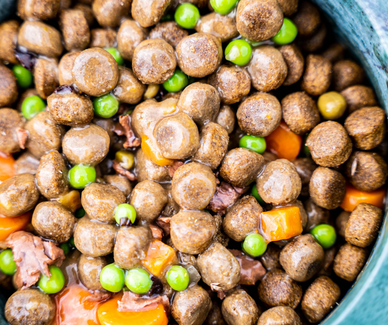
First aid for difficult eaters
About routines, types of food and toppings for dogs and cats
Very annoying, a difficult eater in the house. But also cause for concern: why do those sweet four-legged friends turn their noses up at that delicious food you serve them? Are they getting enough nutrients? But above all: how do we make meals pleasurable for them again?
Reasons why your pet is a difficult eater
Some pets have famously diva strokes and turn their heads as soon as you trot up with a feeding dish. Others look at you resignedly and take a few bites with long teeth. Still others - labrador type for example - go through life under the motto "what I see, I eat".
Ask yourself if your dog or cat has always had antics when it comes to food. If it has eaten with relish most of its life and only recently abandoned its food, maybe there is more to it. As soon as you are concerned, you should consult your veterinarian.
Also, a lot depends on the breed and personality of your pet. In dogs, small dogs are less likely to be triggered by food than larger breeds such as retrievers. So don't worry if your dog is more triggered by attention or games than by snacks or food.
Perhaps your dog or cat has an unpleasant experience attached to food. Whether something happened to you or a previous owner, your pet may make a certain link between a type of food and how he felt at the time. If so, see if you see a different reaction with a different type of food or a different way of eating such as spreading it around on the floor instead of in a bowl.
Finally, it's important to know that dogs and cats don't mind eating the same thing every day. Since we ourselves quickly get bored if we eat the same thing every day, we assume that our pets also like different flavors. In many cases, this is how you create a difficult eater yourself: lots of variety in taste and texture can be very overwhelming for your dog or cat.
Here's how to help your dog or cat
1. A fixed routine
Even if you think your pet will eat if he is hungry enough, it is not a good idea to stop filling his food bowl. Both dogs and cats need regular food. Rather, try if a set routine helps your pet move forward.
For both dogs and cats, it often helps to offer food in the morning, leave it for 15 to 30 minutes and then take it away again until the next meal. Then repeat this: you leave the food for 15 to 30 minutes, and take away what your cat hasn't eaten. Do this 4 to 5 times a day. If you see that your dog or cat begins to eat more per meal, decrease the frequency.
2. Textures and flavors.
Maybe your dog or cat has a specific preference for a particular texture or flavor. Then find out what the favorite is, dry or wet food, fish, poultry, beef or lamb. Your dog or cat will quickly let you know which is his favorite.
Discover all the flavors and textures of our range:
Delcon dog food
Delcon cat food
3. Use a topping
Toppings are liquid flavor bombs that you pour over your dog's or cat's kibble. This way, you don't have to experiment with an assortment of different flavors and textures. You take the kibble you normally give your dog or cat and enrich it with a topping.
Look for a topping that is nutritious like Delcon's food toppings. These are packed with greens such as peas, carrots and peppers. Superfoods for your dog or cat full of vitamins and minerals, grain-free and additive-free.
The preparation is very simple: you pour the topping over your dog's or cat's kibble and mix everything together. Quick, healthy and packed with flavor. Even the pickiest dogs and cats are convinced!
Delcon toppings for dogs
Delcon toppings for cats
Bet these tips will get your cat purring with delight and your dog wagging his tail at every meal.
Remember:
If you are concerned about your dog or cat's eating habits, visit your veterinarian.
Any questions about Delcon's nutrition, ask our team right away via the contact form.
Want to learn more about the benefits of Delcon Pet Food?
Why dog food from Delcon?
Why cat food from Delcon?
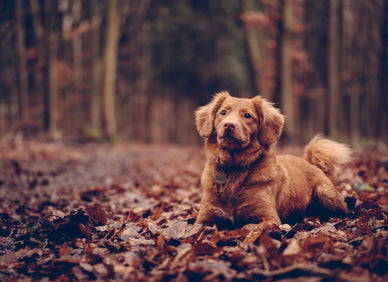
Why does my dog wipe its paws?
Have you also wondered why dogs wipe their paws?
Wiping feet after their need, it occurs in all dogs. You've most likely already wondered what the point of it is?
This behavior can occur in all dogs, but that's not necessarily why they all do it. It looks playful since it looks like they are "washing their hands" after they have done their need yet it does not have such an obvious explanation.
The sweeping on the ground is actually meant to spread their scent. By wiping over their pee, they spread the scent over a larger area. They also use the scent of their paws to turn on the marking. Under the soles of their feet there are glands that allow the dogs to develop a personal scent. By wiping their paws they not only spread the scent of their pee but also their personal scent.
TIP: Do not wash your dog's paws with shampoo. They like it better if they can keep their own scent.
Why spread their scent?
But why is it necessary to spread their scent? Well, communication of dogs is largely done through their nose. By spreading their scent, they let other four-legged friends know of 'hey, I passed here'. This marking behavior occurs in all types of dogs, from the largest to the smallest breeds. Spreading their scent is not necessarily equivalent to marking territory, rather it is a way of communicating with their peers.
Way of communication
If there are changes in the environment of a dog, it can suddenly show marking behavior. Or if you meet another dog during the walk, your dog may also start marking to show his toughness towards the other dog. This behavior is completely well-intentioned and is certainly not a behavior you should unlearn. Wiping their paws is part of being a dog.
Keep watching their body language. If your dog is suddenly angry or tense, then wiping their paws may be accompanied by some sort of aggression. So be sure to watch their stress signals such as staring or fixating or their tail going straight up. So be sure to distract your dog at such a time and make sure he fixes his attention on something nice.
The behavior is certainly nothing to worry about. Do keep an eye on changes in your dog's behavior. Does he pretty much always wipe his paws and suddenly stop doing this? Then this could indicate pain. If you think you notice something, always consult a veterinarian.
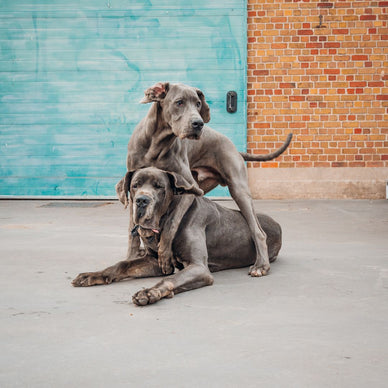
De juiste hondenvoeding per levensfase
Geef je hond voeding die met hem meegroeit.
Waarom voeding aangepast aan de leeftijd ertoe doet.
Als hondenbaasje wil je het beste voor je viervoeter. Daarin speelt voeding een sleutelrol. Net zoals de voedingsbehoeften van mensen veranderen naargelang hun levensfase, heeft ook je hond andere voeding nodig als hij ouder wordt. De juiste voeding op het juiste moment ondersteunt groei, gezondheid en levenskwaliteit.
In deze blog kom je te weten wanneer je overschakelt van puppyvoeding naar volwassen voeding, en van volwassen voeding naar seniorvoeding. We bespreken ook de unieke eigenschappen van hondenvoeding per levensfase en delen rasspecifieke weetjes.
Wanneer schakel je over van puppyvoeding naar adult voeding?
Voeding die specifiek is ontwikkeld voor puppy’s, is cruciaal voor een goede start. Puppy's groeien razendsnel tijdens hun eerste levensjaar. Hun botten, spieren, immuunsysteem en hersenen ontwikkelen zich intensief. Daarom hebben ze voeding nodig die rijk is aan hoogwaardige eiwitten, vetten, vitaminen en mineralen. Delcon Puppy bevat de ideale balans van voedingsstoffen om aan al hun behoeften te voldoen.
Probeer onze proefpakketten volgens de leeftijd van jouw hond
Het juiste moment om over te schakelen:
Voor kleine hondenrassen (zoals een Chihuahua) gebeurt de overgang van puppyvoer naar adult hondenvoeding (meestal) rond de leeftijd van 12 maanden.
Middelgrote honden (zoals een Border Collie) schakelen over naar Delcon Junior rond 8 à 9 maanden. Van zodra ze 12 à 15 maanden oud zijn, mag je hen adult brokken voorschotelen.
Grote rassen (zoals een Golden Retriever) blijven soms tot 6 maanden op puppy- en juniorvoeding, omdat hun groei langer duurt. Ze krijgen Delcon Puppy tot ze 6 maanden zijn en schakelen dan over op Delcon Junior tot ze de leeftijd van 12 maanden hebben bereikt.
Je hoeft de overschakeling van de ene naar de andere variant niet te spreiden, zolang je bij Delcon blijft. Al onze variëteiten hebben namelijk dezelfde basis. Het is vooral de proteïnebron, de proteïnepercentages en de vetpercentages die verschillen.
Delcon heeft bovendien een variëteit voor Junior honden. Het is het perfecte voer voor oudere puppy’s die helpen bij de opbouw van de spiermassa, en de ontwikkeling van gewrichten ondersteunen.Volwassen of adult honden hebben net als puppy’s en junior honden brokken nodig die hun activiteiten ondersteunt. Een evenwichtige mix van energie, eiwitten en gezonde vetten blijft weliswaar belangrijk. Delcon Adult biedt deze balans en is verkrijgbaar in varianten voor kleine (mini) honden en middelgrote & grote honden.
Wanneer is je hond een senior?
Ook hier is er een verschil in de grootte van de hond:
Kleine hondenrassen worden als senior beschouwd vanaf ongeveer 10 jaar.
Middelgrote honden schakelen over rond de leeftijd van 8 jaar.
Grote rassen, die doorgaans sneller verouderen, hebben al vanaf 7 jaar baat bij seniorvoeding.
Seniorvoeding, zoals Delcon Senior, is aangepast aan een trager metabolisme en bevat extra vezels, minder calorieën en specifieke voedingsstoffen zoals glucosamine en chondroïtine om hun gewrichten en mobiliteit op peil te houden. In ons assortiment vind je ook een variant die specifiek is ontwikkeld voor kleine (mini) hondenrassen:
Er zijn ook honden die nooit overschakelen naar senior brokken. Het is dan ook belangrijk om naar het activiteitsniveau van je hond te kijken. Sommige honden zijn heel hun leven erg actief en ondervinden nooit gewrichtsproblemen. Zo’n honden ondersteun je het best met hun vertrouwde adult brokken. Vraag je je af of jouw hond beter overschakelt naar onze senior variëteit of beter bij de adult brokken blijft? Neem contact op voor persoonlijk advies of stuur ons een berichtje via de chat.
Overzicht: voeding aanpassen volgens de leeftijd van je hond
Kleine honden
Middelgrote honden
Grote honden
Delcon Puppy
Tot 9 à 12 maanden
Tot 8 maanden
Tot 6 maanden
Delcon Junior
/
Vanaf 8 maanden tot 12 à 15 maanden
Vanaf 6 maanden tot 12 maanden
Delcon Adult
Vanaf 9 à 12 maanden tot ongeveer 10 jaar
Vanaf 12 à 15 maanden tot ongeveer 8 jaar
Vanaf 12 maanden tot ongeveer 7 jaar
Delcon Senior*
Vanaf ongeveer 10 jaar
Vanaf ongeveer 8 jaar
Vanaf ongeveer 7 jaar
*Of je hond beter overschakelt naar senior hondenvoeding, hangt af van het activiteitsniveau en de algemene gezondheid van je hond. Contacteer ons voor advies op maat.
Probeer een proefpakket
Zo herken je hondenvoeding die de gezondheid van je hond ondersteunt
Nu je weet wanneer je moet overschakelen van de ene naar de andere leeftijdsvariant, is het belangrijk om te weten welke voedingsstoffen belangrijk zijn voor je hond.
Puppyvoeding: focus op groei en energie
Omdat je pup in razendsnel tempo groeit en hun hersenen een enorme ontwikkeling doormaken, heb je voeding nodig die hen daarin ondersteunt. Kijk daarom op het etiket en hou rekening met:
Een hoog eiwit- en vetgehalte
Percentage omega 3 vetzuren
Extra toevoeging van calcium en fosfor
Volwassen voeding: gezond gewicht, spieren, huid en vacht
Je volwassen hond heeft net als een puppy of junior hond bepaalde behoeften om gezond te blijven en sterke spieren, gewrichten en botten te behouden. Let daarom zeker op deze elementen als je adult voeding kiest:
Omega 3 en Omega 6 vetzuren uit onder andere premium zalmolie.
Hoogwaardige eiwitten uit gedehydreerd vlees.
Evenwichtig caloriegehalte op maat van het energieniveau van je hond.
Natuurlijke ingrediënten zonder kunstmatige toevoegingen.
Senior voeding: vlotte spijsvertering en soepele gewrichten
Als je merkt dat het metabolisme van je hond vertraagt, en zijn gewrichten en botten meer ondersteuning nodig hebben, schakel dan over naar Senior brokken. Sommige honden blijven actief zonder gewrichtsklachten, Daarom bevat Senior hondenvoeding best:
Minder calorieën
Extra vezels
Glucosamine en chondroïtine
De ene hond is de andere niet
Kleine honden hebben over het algemeen een sneller metabolisme. Ze verbranden meer calorieën per kilogram lichaamsgewicht dan middelgrote en grote honden. Daarom hebben ze voeding nodig met een hogere caloriedichtheid. Ook de brokgrootte doet ertoe voor hen: kleinere brokjes aangepast aan hun kleine kaken.
Grote en middelgrote honden hebben daarentegen voeding nodig die hun spieren, botten en gewrichten optimaal ondersteunt. Heel belangrijk is een evenwichtige samenstelling die overgewicht voorkomt zonder in te boeten aan gezonde vetten en eiwitten.
Het is niet enkel belangrijk om de voeding aan te passen aan de leeftijd van de hond, maar ook aan de grootte. Zo ben je zeker dat je hond elke dag de voedingsstoffen krijgt die hij nodig heeft om zich gezond te ontwikkelen.
Heeft jouw hond klachten? Kies een proefpakket volgens zijn behoeften.
5 redenen om te kiezen voor Delcon hondenvoeding!
Al onze voeding is in samenwerking met dierenartsen en voedingsdeskundigen ontwikkeld.
We werken enkel met natuurlijke, hoogwaardige ingrediënten.
Onze Product Finder helpt je de juiste voedingskeuze maken op maat van je hond.
Geschikt voor elke levensfase dankzij verschillende varianten voor puppy’s, juniors, adults en seniors. Inclusief specifieke variëteiten voor de kleinste hondenrassen.
Kwalitatieve voeding van eigen bodem, altijd beschikbaar in een winkelpunt in de buurt of online.
Probeer het zelf!
De juiste voeding per levensfase is essentieel om de gezondheid en levenskwaliteit van je hond te verzekeren. Door te kiezen voor voeding die is afgestemd op hun leeftijd, ras en grootte, geef je jouw hond de beste kans op een gezond en gelukkig leven.
Delcon biedt daarom kwalitatieve hondenvoeding voor elke levensfase en ondersteunt je hond in elke stap van zijn levenscyclus. Bestel je proefpakket en ondervind zelf hoe Delcon de gezondheid van je hond bevordert.
Je Delcon proefpakket bestellen
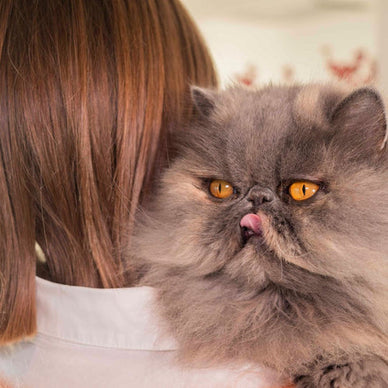
Haarballen bij katten: beter voorkomen dan genezen
Haarballen bij katten: beter voorkomen dan genezen
Haarballen of trichobezoaren zijn een veelvoorkomend fenomeen bij katten. Hoewel ze vaak onschuldig zijn, kunnen ze in sommige gevallen toch voor gezondheidsproblemen zorgen. In deze blog ontdek je alles over haarballen bij katten, van oorzaken en symptomen tot preventie en tips. Spoiler alert: kwalitatieve voeding (zoals die van Delcon) ondersteunt je kat.
Zijn haarballen gevaarlijk?
Neen, de meeste haarballen zijn onschuldig. In bepaalde situaties haal je er toch best een dierenarts bij. Meer bepaald wanneer bepaalde symptomen lang aanhouden, zoals wanneer je kat voor een langere periode:
kokhalst zonder braaksel of haarbal.
tekenen van verstopping vertoont.
niet meer eet of drinkt.
lusteloos is.
In zeldzame gevallen komt een haarbal vast te zitten en moet de dierenarts chirurgisch ingrijpen.
Zo ontstaat een haarbal:
Katten staan bekend om hun goede verzorgingsgewoonten. Door zichzelf regelmatig te likken, houden ze hun vacht schoon en vrij van vuil. Daarbij slikken ze ook kleine hoeveelheden haar in. Dit haar passeert meestal probleemloos door het spijsverteringskanaal en verlaat hun lichaam via de ontlasting. Maar soms kan het zich ophopen in de maag en een haarbal vormen, die ze dan op een gegeven moment uitbraken.
Langharige rassen, meer haarballen?
Dat klopt! Langharige katten zoals een Perzische kat of Maine Coon hebben meer kans op haarballen. Hun dikke vacht produceert simpelweg meer losse haren.
Zijn haarballen seizoensgebonden?
Het risico op haarballen is groter tijdens de ruiperiode van katten, meestal in de lente en de herfst. Ze verliezen dan extra veel haar.
Haarballen voorkomen: onze preventietips
Haarballen zijn niet te vermijden. Anderzijds zijn er wel verschillende manieren om je kat te helpen minder frequent haarballen te vormen.
Regelmatig borstelenZo verwijder je losse haren voor je kat ze inslikt. Kortharige katten borstel je 1 à 2 keer per week, de vacht van langharige katten heeft dagelijks aandacht nodig.
Voeding op maat van je katKatten hebben heel specifieke voeding nodig. Zo is de vleeswaarde van nat of droog kattenvoer heel belangrijk. Katten zijn namelijk carnivoren. Dat is iets dat Delcon goed heeft begrepen. Ons kattenvoer is in samenwerking met dierenartsen ontwikkeld om de gezondheid van je kat te ondersteunen.We letten bijvoorbeeld op het vezelgehalte van ons kattenvoer. Dat helpt om de ingeslikte haren door de spijsverteringskanalen te leiden. Denk aan oplosbare vezels zoals bietenpulp, cichorei, lijnzaad en appel. Die vormen een soort gel die de haartjes door het spijsverteringsstelsel van je kat leiden. Onoplosbare vezels verhogen daarnaast het volume van de ontlasting van katten en duwen de haren zo uit hun lichaam.
Tijd voor zen Hoe vaker katten zich likken, hoe meer kans dat ze haren inslikken. Een teken van stress bij katten is overdadig likken. Een rustige omgeving, voldoende uitdaging (bijvoorbeeld via speeltjes) en aandacht zorgen voor een gelukkige kat.
Goede voedingsstoffen als wapen tegen haarbalellende
Om de haren vlot uit hun lichaam te kunnen drijven hebben katten voeding nodig die hun spijsverteringstelsel ondersteunt. Door de juiste voeding te geven, ondersteun je dit proces en voorkom je dat haren zich ophopen in de maag van je kat. Katten die vaak problemen ondervinden met haarballen zijn bijvoorbeeld geholpen met voeding waarin voldoende vezels zitten.
Ook Omega-3 en Omega-6 vetzuren helpen je kat onrechtstreeks. Door een gezonde huid en een glanzende vacht te bevorderen, wordt de kans op haaruitval en overdadig likken kleiner. Hetzelfde geldt voor hoogwaardige dierlijke eiwitten die de vacht van katten voedt zodat ze minder haar verliezen. Kattenvoeding met een hoge vleeswaarde bevat bijvoorbeeld taurine, vitamine A en mineralen zoals fosfor en calcium die verschillende voordelen hebben voor de gezondheid van katten.
Welke voedingsstoffen vermijden om haarbalperikelen te voorkomen?
Kattenvoer kiezen is eigenlijk heel simpel. Koop je voeding met een hoge vleeswaarde, zit je meestal goed. Belangrijk is om koolhydraten te bannen. Katten zijn carnivoren en hebben geen koolhydraten nodig. Meer nog: te veel koolhydraten kunnen leiden tot spijsverteringsproblemen, wat moeilijkheden met haarballen vergroot. Het hoofdingrediënt van kattenvoeding moet dus vlees zijn, geen maïs, tarwe of soja.
Verder zijn hoogwaardige vetzuren cruciaal voor de gezondheid van je kat. Denk bijvoorbeeld aan vetzuren zoals omega 3 en omega 6. Omega 3 heeft een positieve impact op de huid en de vacht van katten terwijl omega 6 hun huidbarrière versterkt.
De beste kattenvoeding om haarballen te voorkomen
Er is een groot arsenaal kattenvoer op de markt die je kat helpt bij problemen met haarballen of deze problemen net voorkomt. Heel belangrijk is dat je de etiketten goed leest. Kies daarbij steevast voor kattenvoer met een hoge vleeswaarde. Delcon kattenvoer werkt bijvoorbeeld met gedehydreerd vlees, vlees in zijn puurste vorm. Door al het vocht te onttrekken, verwijst de vleeswaarde op onze etiketten enkel naar het vleesgehalte en niet het vochtgehalte. Zo komen we aan een vleeswaarde tussen de 33% en 40%. Vol kwalitatieve, dierlijke eiwitten!
Delcon kattenvoer is ook graanvrij. Dat is een bewuste keuze. Katten hebben geen granen nodig en kunnen het ook maar in beperkte mate verteren. Als strikte carnivoren is hun spijsverteringsstelsel aangepast aan dierlijke eiwitten, niet aan zulke koolhydraten. Kiezen voor graanvrij katteneten is daarom een goede zet bij haarbalpreventie. Anderzijds hebben katten wel andere koolhydraten nodig, in de juiste verhoudingen. In Delcon kattenvoeding zit daarom aardappel en zoete aardappel. Koolhydraten die wel goed zijn voor je kat.
Daarnaast controleer je best ook de toegevoegde vitamines en mineralen in de voeding. Katten halen voor een gezonde huid en vacht voordeel uit extra Vitamine A, Zink en Omega 3 en 6. Wat ook indirect problemen met haarballen kan voorkomen. Omega 3 en 6 zijn rijkelijk aanwezig in de kattenvoeding van Delcon. In de varianten voor volwassen katten zijn dit de percentages:
Omega 3: ongeveer 1,0%.
Omega 6: tussen de 3,1% en de 3,4%.
EHBH: Eerste Hulp Bij Haarballen
Symptomen van haarballen bij katten
Niet alle katten hebben symptomen wanneer ze een haarbal vormen. Maar als je kat een haarbal probeert uit te braken, zie je dat meestal hieraan:
Kokhalzen of overgeven (met of zonder haarbal)
Verminderde eetlust
Lusteloosheid
Obstipatie of diarree
Overmatig gras eten
Als de symptomen lang aanhouden, je kat de haarbal niet kan uitbraken of je je zorgen maakt om het gedrag van je kat, neem dan contact op met je dierenarts.
Wat doen als je kat last heeft van een haarbal?
Als je merkt dat je katten moeite hebben om een haarbal uit te braken, help je hen zo:
Observeer
Een haarbal uitbraken of af en toe kokhalzen betekent niet meteen een onderliggend probleem. Hou je katten in de gaten om te zien of hun gedrag verandert.
Water, water en nog eens water
Katten hebben voldoende hydratatie nodig. Zeker als ze voornamelijk droogvoer krijgen. Water helpt katten om ingeslikt haar via hun ontlasting uit te scheiden.
Naar de dierenarts
Als je kat langdurig probeert te kokhalzen zonder resultaat, lusteloos wordt of niet meer wil eten of drinken, neem dan contact op met je dierenarts. In sommige gevallen komt een haarbal vast te zitten en een obstructie veroorzaken.
Hoe vaak heeft een kat een haarbal?
Kortharige katten hebben over het algemeen minder last van een haarbal. Soms een keer per maand maar vaak minder. Langharige katten braken vaker een haarbal uit. In de ruiperiode tot één keer per 3 weken.
Heeft je kat meerdere keren per week haarballen, wijst dit in veel gevallen op een onderliggend probleem zoals stress, huidproblemen of een dieet dat niet bij je kat past.
Conclusie: haarballen voorkomen is beter dan genezen
Haarballen zijn eigen aan katten. Meestal vormen ze geen probleem. Katten die een goed werkend spijsverteringsstelsel en een gezonde huid en vacht hebben, maken minder kans om last te hebben van haarballen. Voeding die beide ondersteunt, helpt je kat haarballen makkelijker te verwerken.
Probeer nu ons proefpakket en ontdek het verschil!

Is your dog overweight?
Owners are only too happy to give their dogs tasty rewards, and some just a little too happy. Because did you know that 35% of pets are overweight† Think your dog is a little overweight, but you're not quite sure? Then there are some ways to check this.
Being overweight can have dire consequences for your dog, such as back problems, heart problems, diabetes, high blood pressure, breathing problems, significant reduction in quality of life, and I could go on and on.
How do you know if your dog needs to lose some pounds?
Check your dog's ribs, is the message! Their ribs should be palpable but not apparent from a distance (this would indicate underweight). The ribs may therefore be covered by a dun layer of fat.
Also look at your dog from different perspectives. Look at him from above, his waist should be clearly visible there. Then look at it from the side, there you should see a retracted belly without excess or hanging fat. It is an obvious sign that your dog is overweight if your dog's ribs are completely covered in fat.
Some dogs are more prone to obesity than others
Females are generally more prone to being overweight than males but there are several breeds that are more likely to be overweight such as Basset Hounds, Beagles, Boxers, Bulldogs, Dachshunds, Golden Retrievers, Labrador Retrievers, Newfoundlands, Pugs and Rottweilers. So pay extra attention to these varieties!
What are the risks of being overweight?
Being overweight in dogs can shorten their life expectancy by an average of 2 years.
They suffer from a loss of fitness. They get tired faster because those extra pounds of fat press on the airways and heart. Due to that reduced condition and less exercise, the risk of heart and lung problems also increases
They are also more likely to develop diabetes
They have an increased risk of impaired liver function due to fatty liver
They also develop bone and joint problems. Overweight dogs almost all develop osteoarthritis after some time.
At warm temperatures they run the risk of overheating more quickly
…
Enough ailments to see that obesity is a clear problem in dogs. Time to do something about it!
How do you make your dog lose weight?
Maintaining a good weight for your dog is vital to his health. So are there a few pounds too much on the scale? Then it's time to make a change in your dog's lifestyle. How do you handle this?
Adjust his diet† This may seem obvious, but it is the most necessary step to get his weight under control. Reduce the amount of food a little bit at a time. So do not suddenly give only half of its normal amount. or pturn its diet to a variety specially formulated to control weight to keep like Delcon Light contains a reduced fat content and yet all the necessary proteins and minerals for a healthy slimming cure.
Get plenty of exercise† In addition to nutrition, exercise is also an important factor to lose a few kilos. Go for a walk with it more often, go to an off-leash meadow where you can let your dog run wild. Play active games with him. Doing more activities with your dog will also help his weight drop faster.
Curious to try out diet food for your dog? View our Light dog food here

Wanneer overschakelen op hypoallergene hondenvoeding?
Sommige honden lijken voortdurend met hun gezondheid te sukkelen: jeuk, oorontstekingen, dunne ontlasting, doffe vacht of overgeven. Misschien herken je je viervoeter er wel in. Dan is de kans groot dat jouw hond last heeft van een voedselintolerantie of -allergie.
Gelukkig hoeft dit zijn leven niet te blijven bepalen. De juiste voeding brengt comfort, energie en levensplezier terug. Bij Delcon weten we hoeveel verschil de juiste voeding maakt. Net daarom doen we veel onderzoek naar hypoallergene voeding en breiden we ons assortiment steeds verder uit naar bijvoorbeeld hypoallergene voeding voor puppy’s, juniors en kleine rassen.
Het Delcon assortiment hypoallergene hondenvoeding
Voedselintoleranties en -allergieën herkennen: wat zijn de symptomen bij honden?
Voedselintolerantie of allergieën bij honden zijn zeker geen zeldzaamheid. Net zoals bij mensen reageert het lichaam van een hond soms overdreven op bepaalde stoffen. Dit kan leiden tot:
Jeuk en overmatig krabben,
Likken of bijten aan poten,
Een doffe of schilferige vacht
Verminderde eetlust of futloosheid
Terugkerende oorontstekingen,
Braken en/of diarree,
Gevoelige huid of huidproblemen
Deze klachten zijn niet enkel vervelend, ze tasten ook het algemene welzijn van je hond aan. Gelukkig maakt hypoallergene voeding vaak een wereld van verschil.
Hoe helpt hypoallergene voeding je hond?
Het Delcon assortiment hypoallergene voeding is speciaal ontwikkeld voor honden met een gevoelig spijsverteringsstelsel, intoleranties of allergieën. Door bepaalde ingrediënten bewust weg te laten en te werken met één zorgvuldig gekozen proteïnebron, vermijd je dat het immuunsysteem van je hond overprikkeld raakt.
Bij Delcon nemen we dit principe serieus. Onze Delcon Hypoallergenic lijn bevat per variant maar één dierlijke eiwitbron zoals lam of eend. Geen mengelingen of onverwachte toevoegingen, wél pure en zorgvuldig geselecteerde ingrediënten.
Daarnaast zijn al onze hypoallergene recepten ook:
Graanvrij
Rijk aan natuurlijke prebiotica (voor gezonde darmflora)
Vervaardigd met zoete aardappel (een goed verteerbare energiebron)
Vrij van kunstmatige kleur- of smaakstoffen
Als Belgisch kwaliteitsmerk kiezen we bovendien bewust voor lokale, hoogwaardige ingrediënten.
Eerst zien en dan geloven? Vraag je proefpakket hypoallergene voeding van Delcon aan en merk zelf de resultaten bij je hond.BESTEL HIER JOUW PROEFPAKKET
Nieuw: hypoallergene voeding voor puppy’s en kleine honden en een extra smaak
Ons gamma hypoallergene voeding werd recent uitgebreid. Naast de vertrouwde Hypoallergenic brokken voor volwassen honden, vind je nu ook varianten voor:
Pyppy's en junior: met aangepaste voedingswaarden en structuur voor jonge honden in volle groei.
Mini-honden: met kleinere brokjes, speciaal ontworpen voor kleine rassen met een gevoelig spijsverteringsstelsel.
Ook adult honden genieten mee want naast lam kunnen ze nu ook eend kiezen als favoriete hypoallergene brok.
Daarnaast zijn er ook hypoallergene snacks voor gevoelige snoepers. Ideaal als tussendoortje of beloning, zonder zorgen.
Waarom kiezen voor Delcon?
Eerst en vooral is Delcon een Belgisch merk met een duidelijke visie: hondenvoeding moet gezond, eerlijk en evenwichtig zijn. We werken daarvoor nauw samen met voedingsdeskundigen en baseren onze recepten op de noden van honden, niet op trends.
Dit maakt ons uniek in België:
Slechts één dierlijke eiwitbron per recept. Zo hou je grip op mogelijke triggers in de voeding van je hond.
Hypoallergene voeding voor alle leeftijden en groottes. Ook voor puppy's, juniors en kleine rassen.
Lokale productie met pure ingrediënten. We staan voor transparantie in elke brok.
Een persoonlijk aanspreekpunt. Onze klantendienst staat voor je klaar bij vragen over ons assortiment.
En het mooiste? Honden met klachten bloeien vaak helemaal open na een overstap naar onze hypoallergene brokken en snacks. Dat lezen we niet alleen in reviews, maar zien we dagelijks in onze community van tevreden baasjes.
Boule lust de hypoallergene voeding heel graag tegenover vorige merken. Hopelijk blijft dit zo en blijven reacties uit. Leefde al jaren op bijna enkel water en brood. R. Huysman
Dit is het enige voer dat alle 3 onze honden lusten. Geen darmproblemen meer en nu goede stoelgang. Top! V Van Der Zalm
Onze Golden Retriever Sky heeft een veel betere stoelgang sinds we Delcon kopen. De service is goed en snel. E. Laermans
Heel blij met jullie kwalitatieve voer! Onze Vizsla heeft eindelijk rustige darmen dankzij jullie hypoallergene eten! A. Fayard
De oplossing voor een betere levenskwaliteit van gevoelige honden
Een voedselintolerantie of -allergie hoeft het leven van je hond niet te bepalen. Met de juiste voeding geef je hem comfort en levensvreugde terug. Delcon helpt je daarbij, met hypoallergene recepten die eenvoudig, puur en Belgisch zijn.
Nieuwsgierig? Bekijk ons gamma online of vraag vandaag nog je proefpakket aan. Je hond is je nu al dankbaar!
Proefpakket online kopen
Verdeelpunten vinden